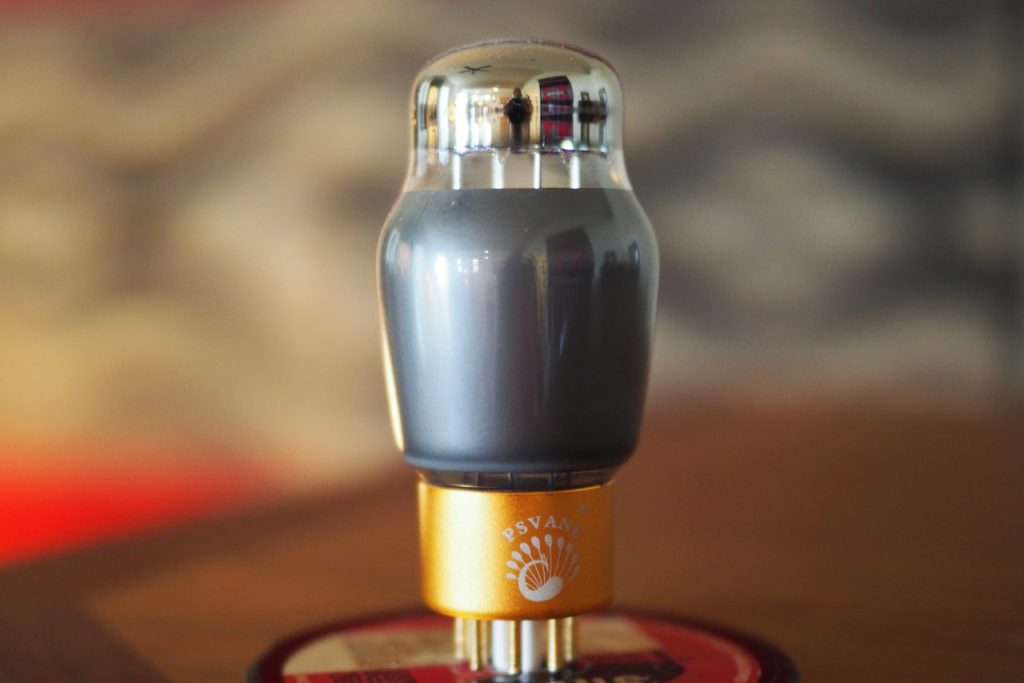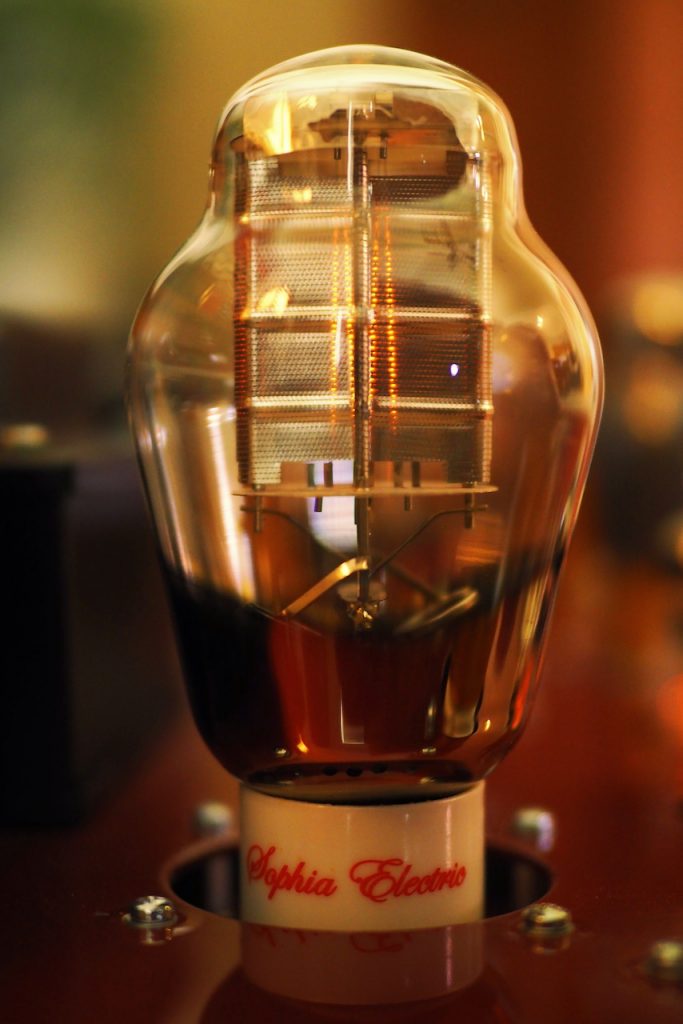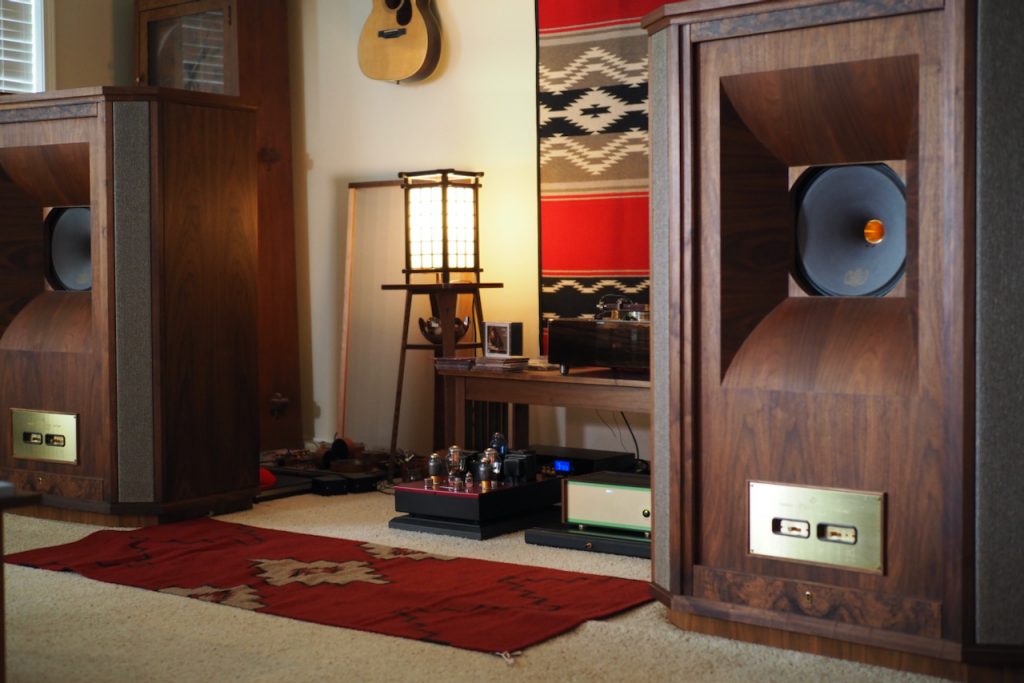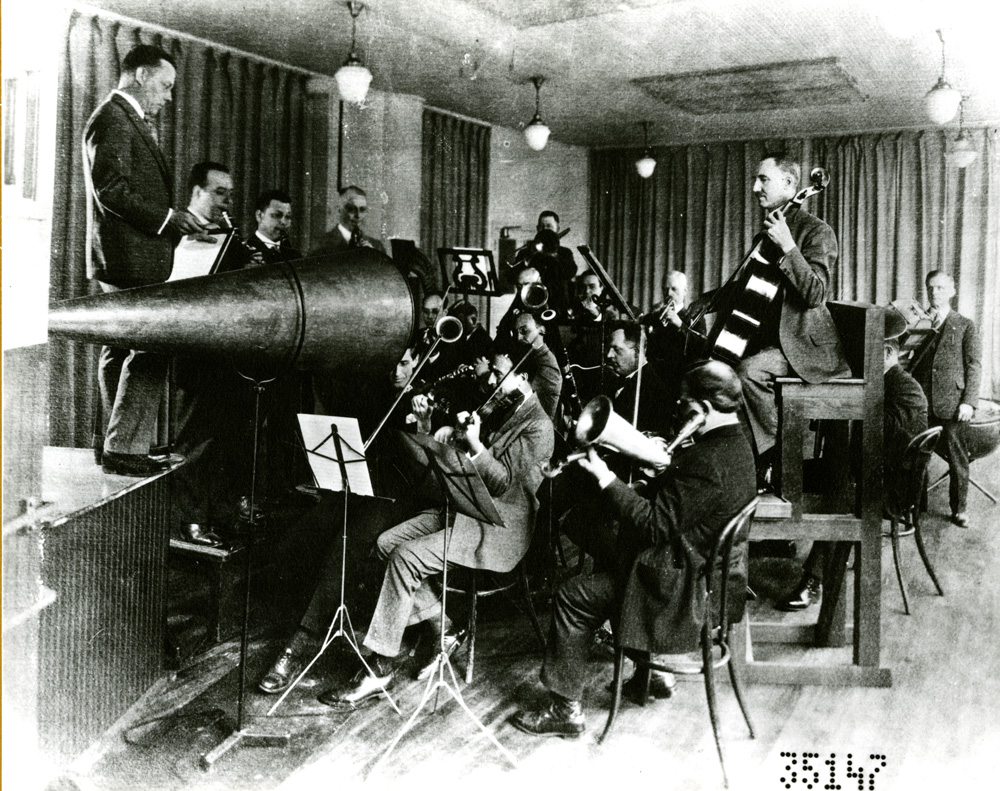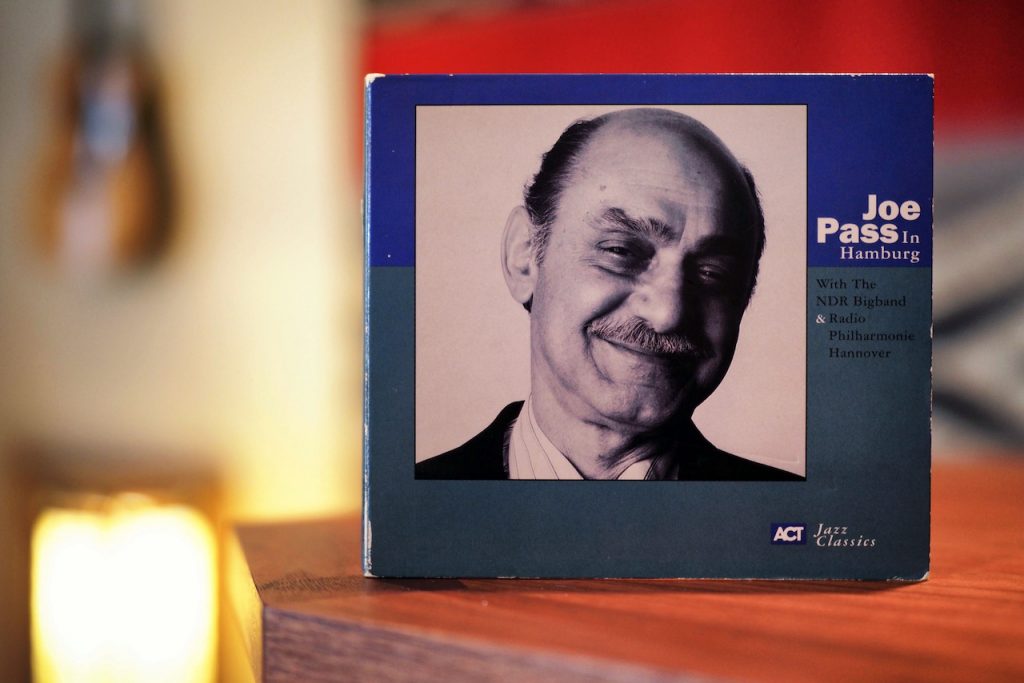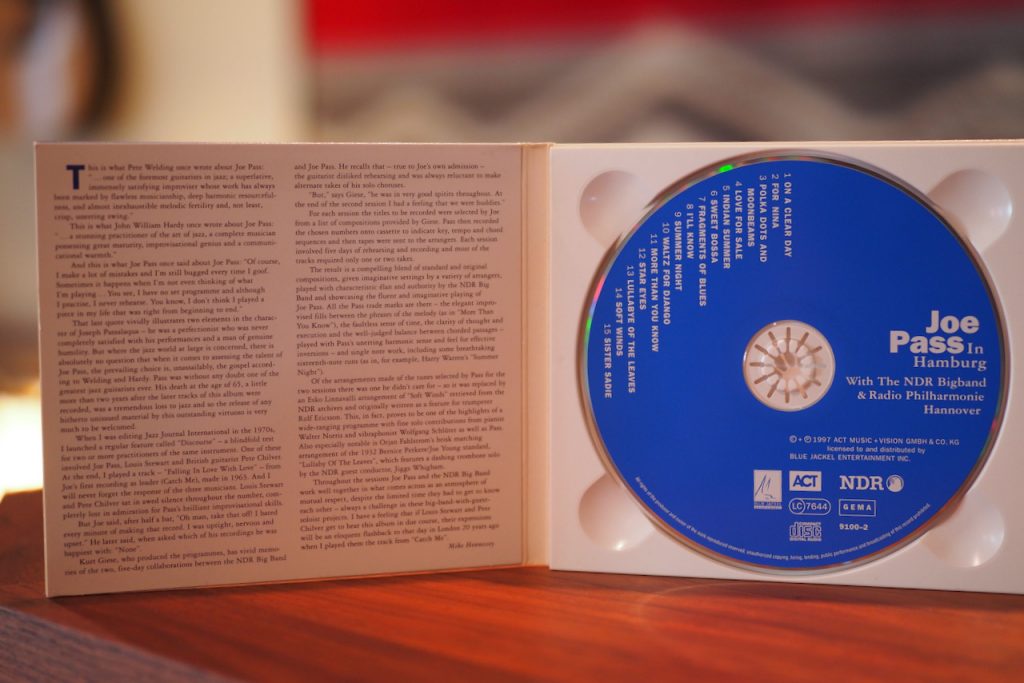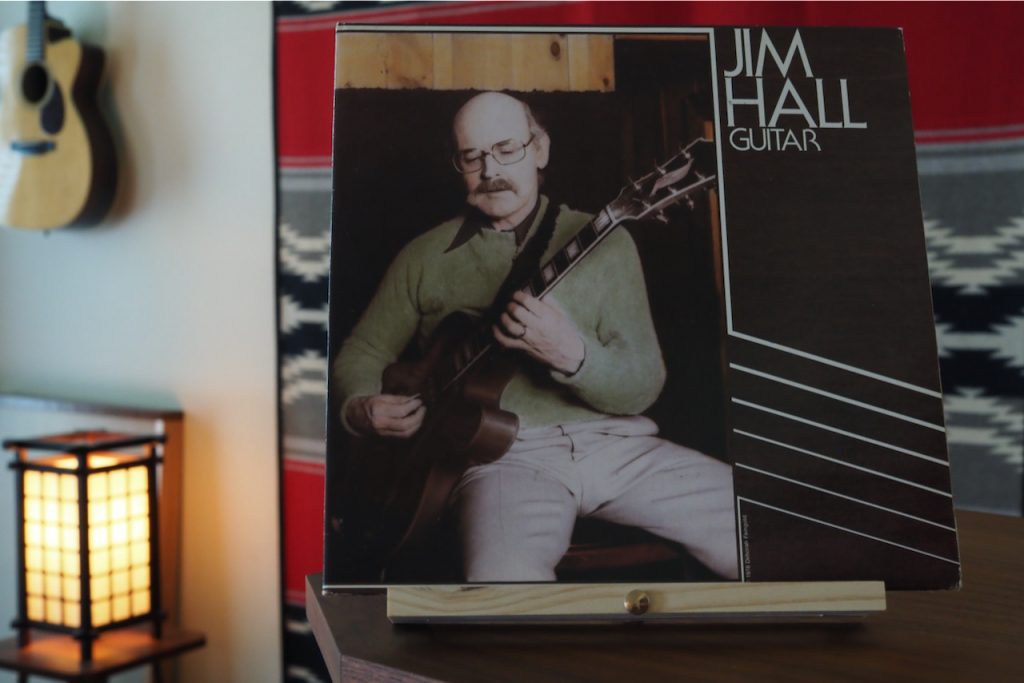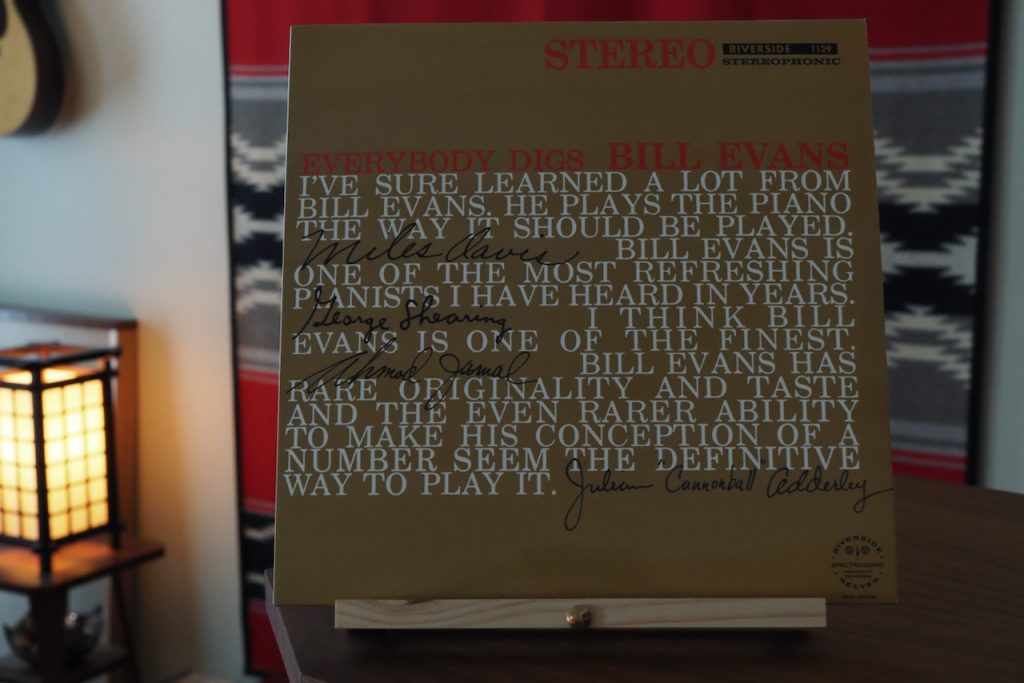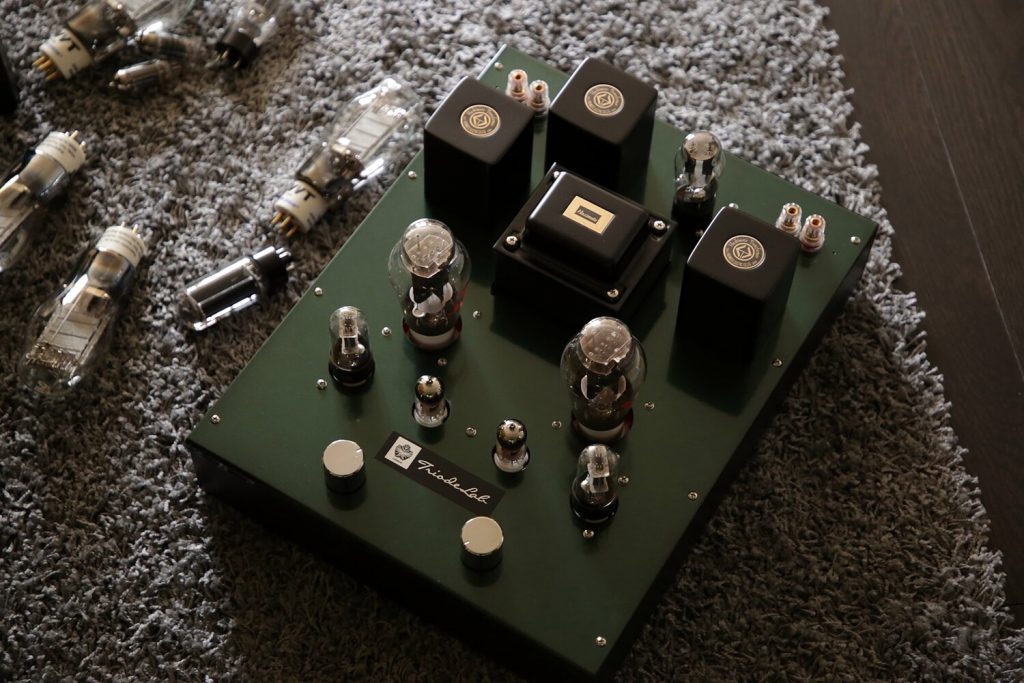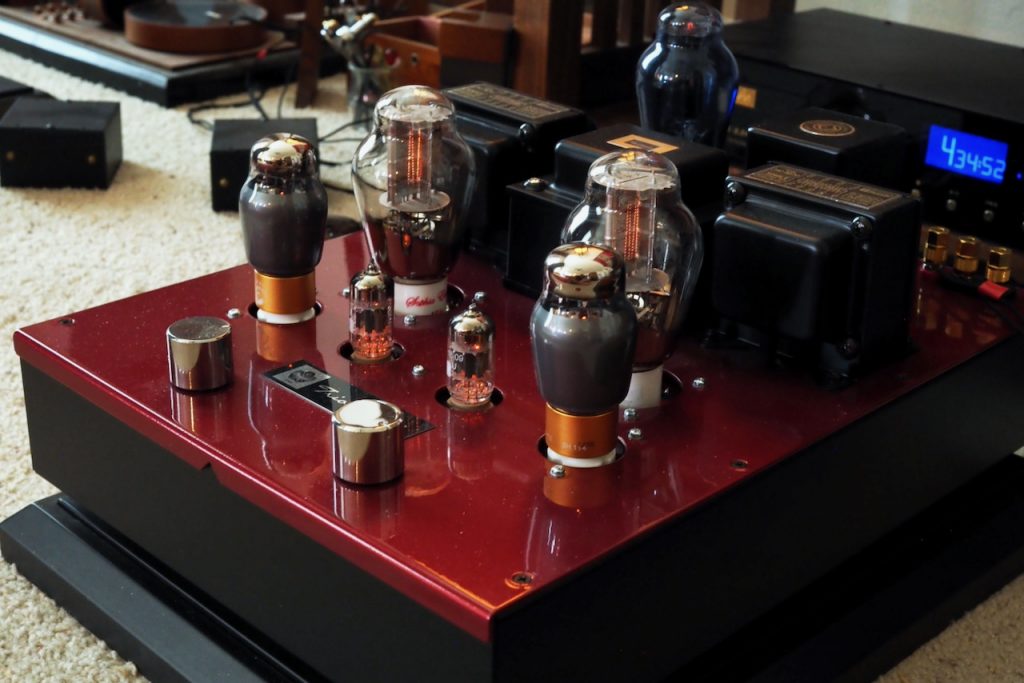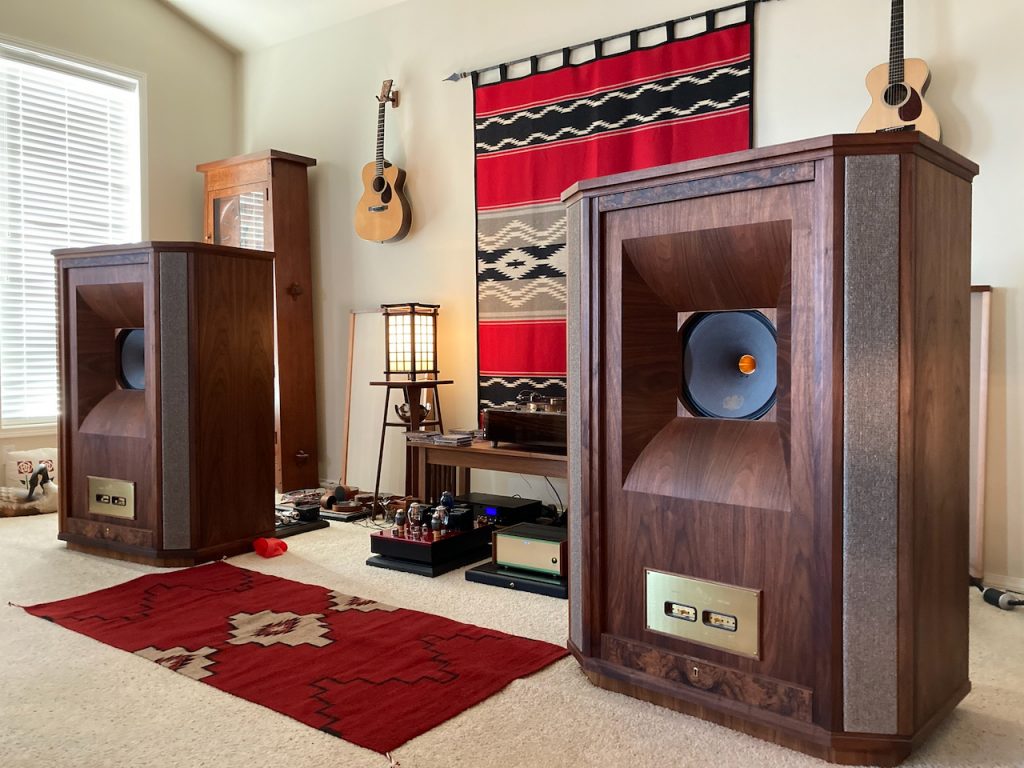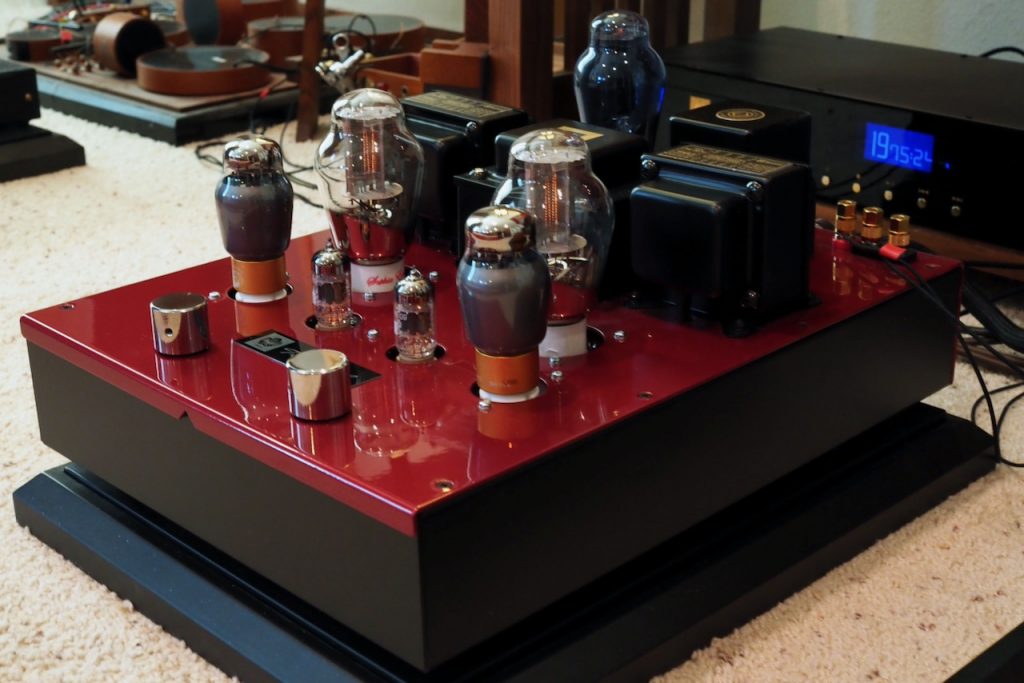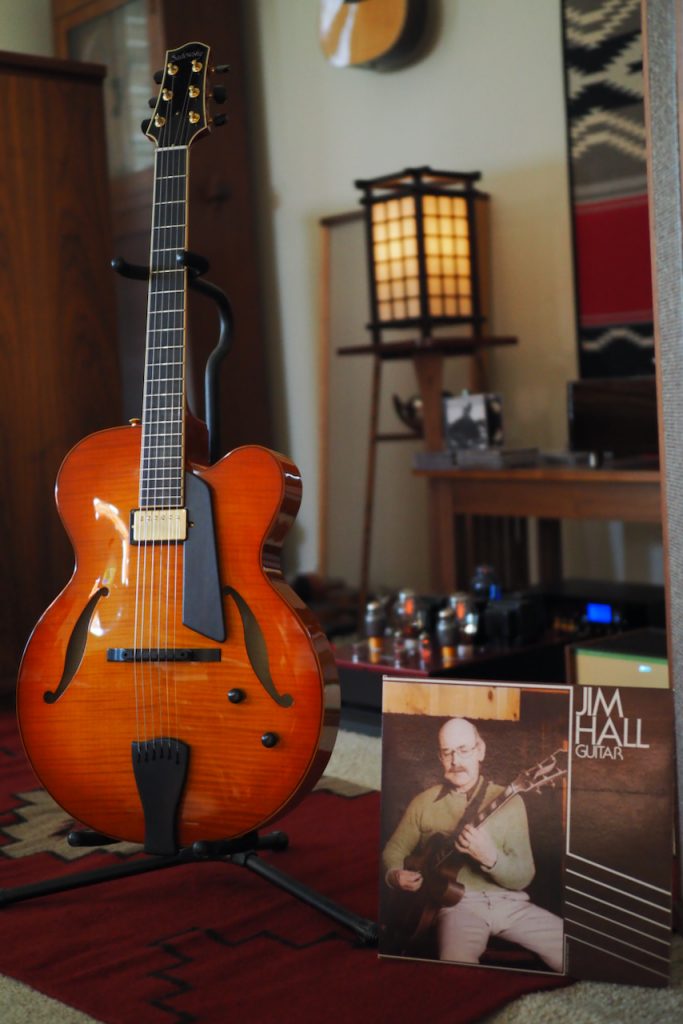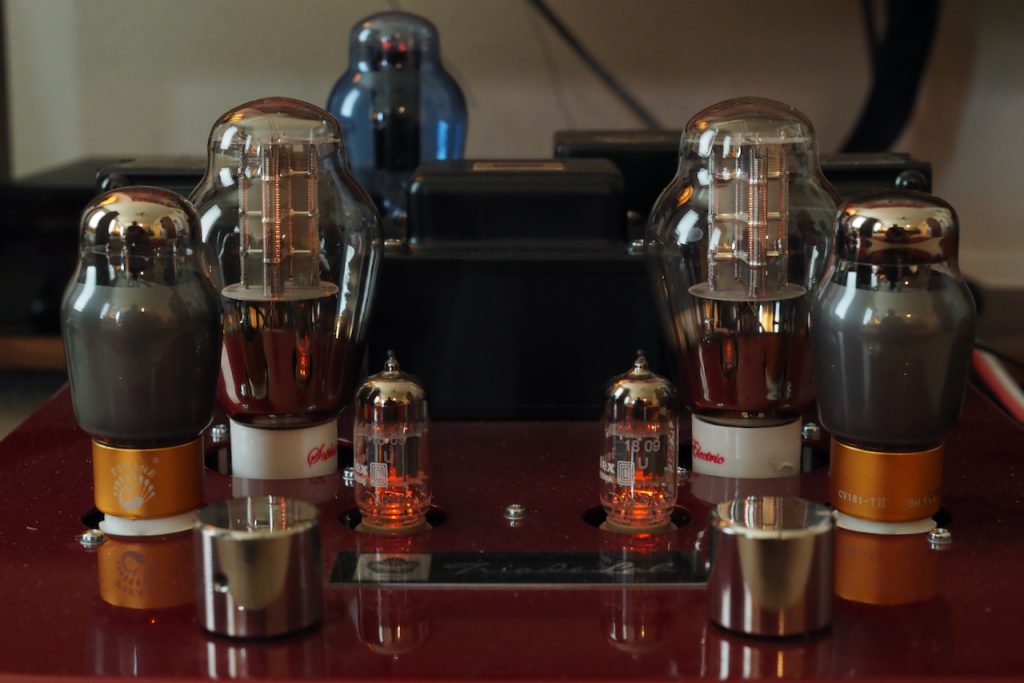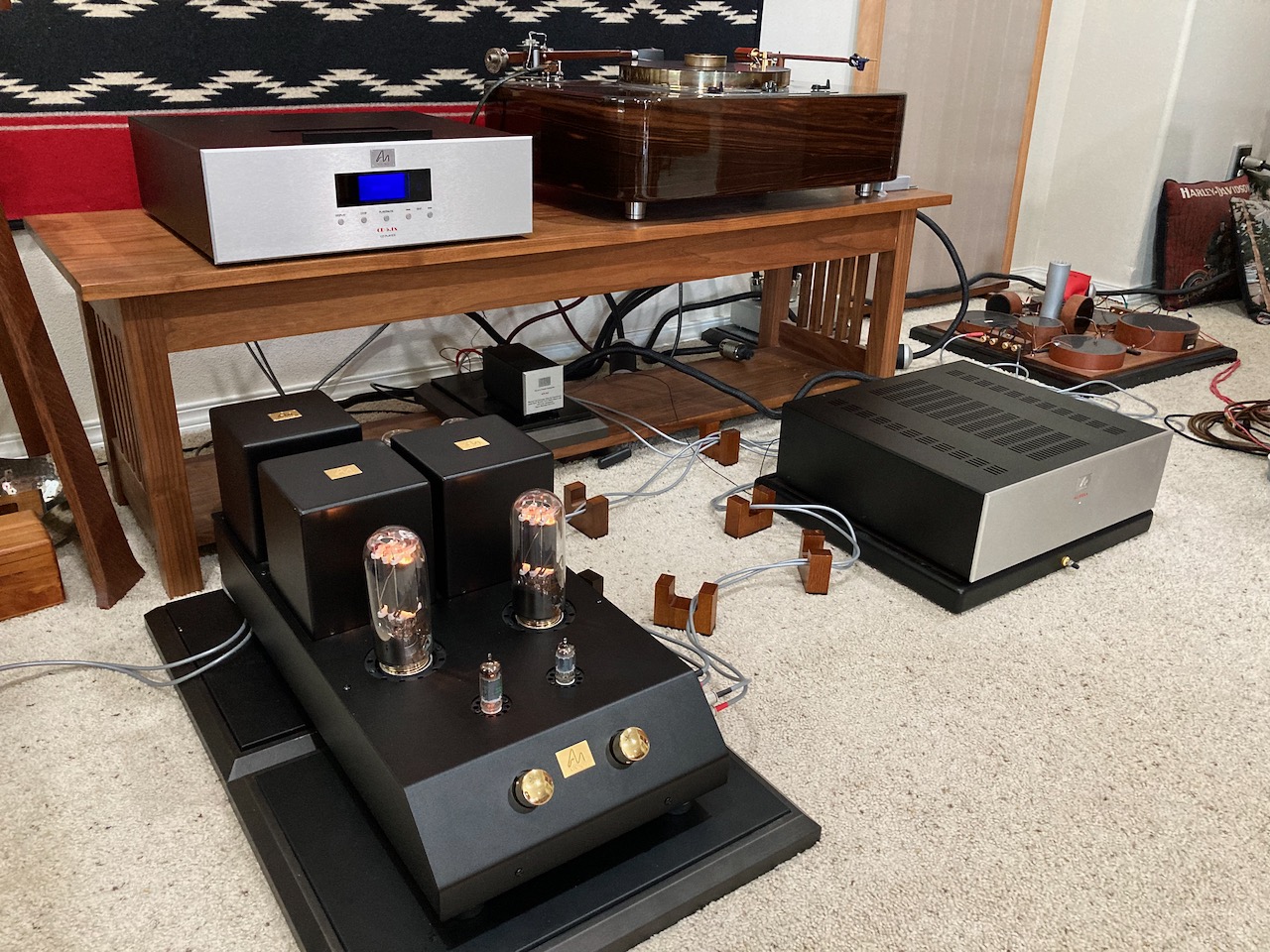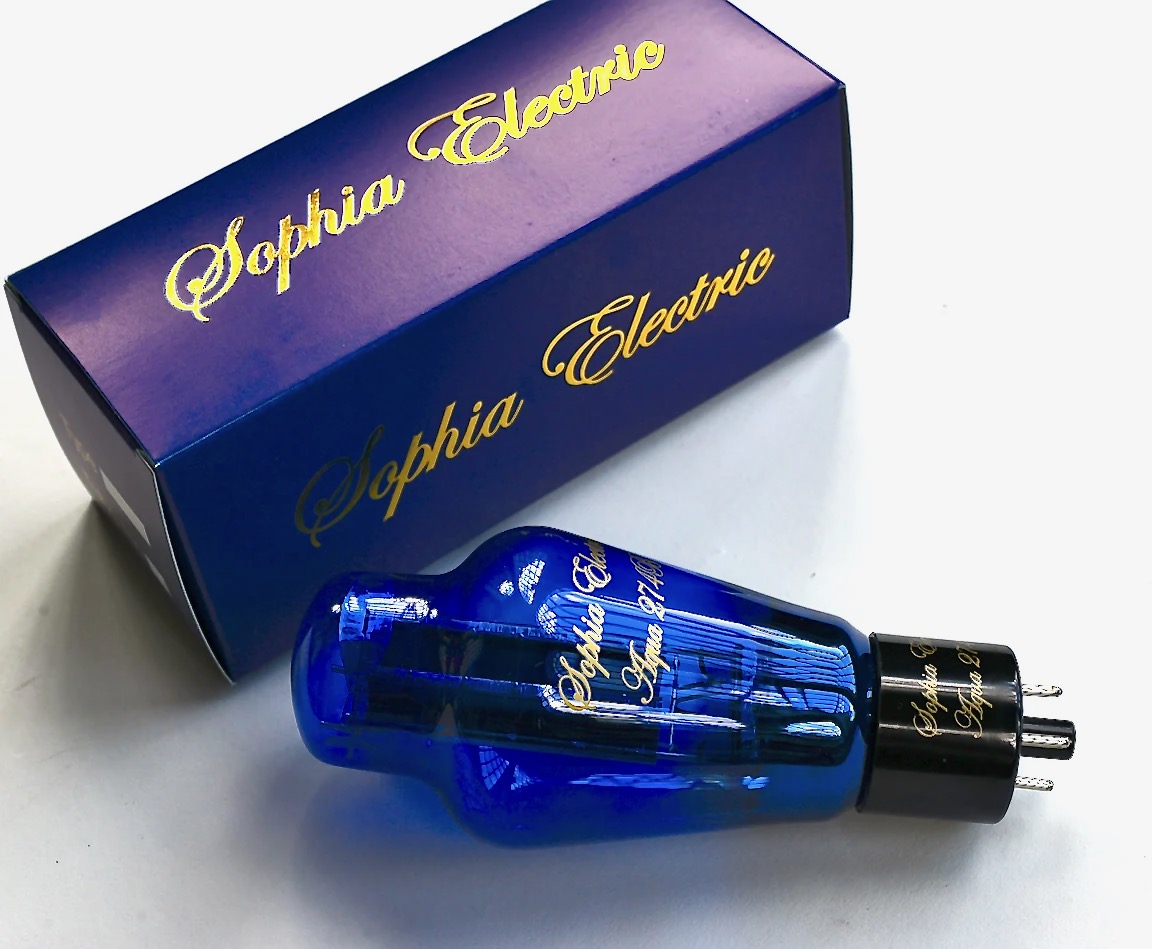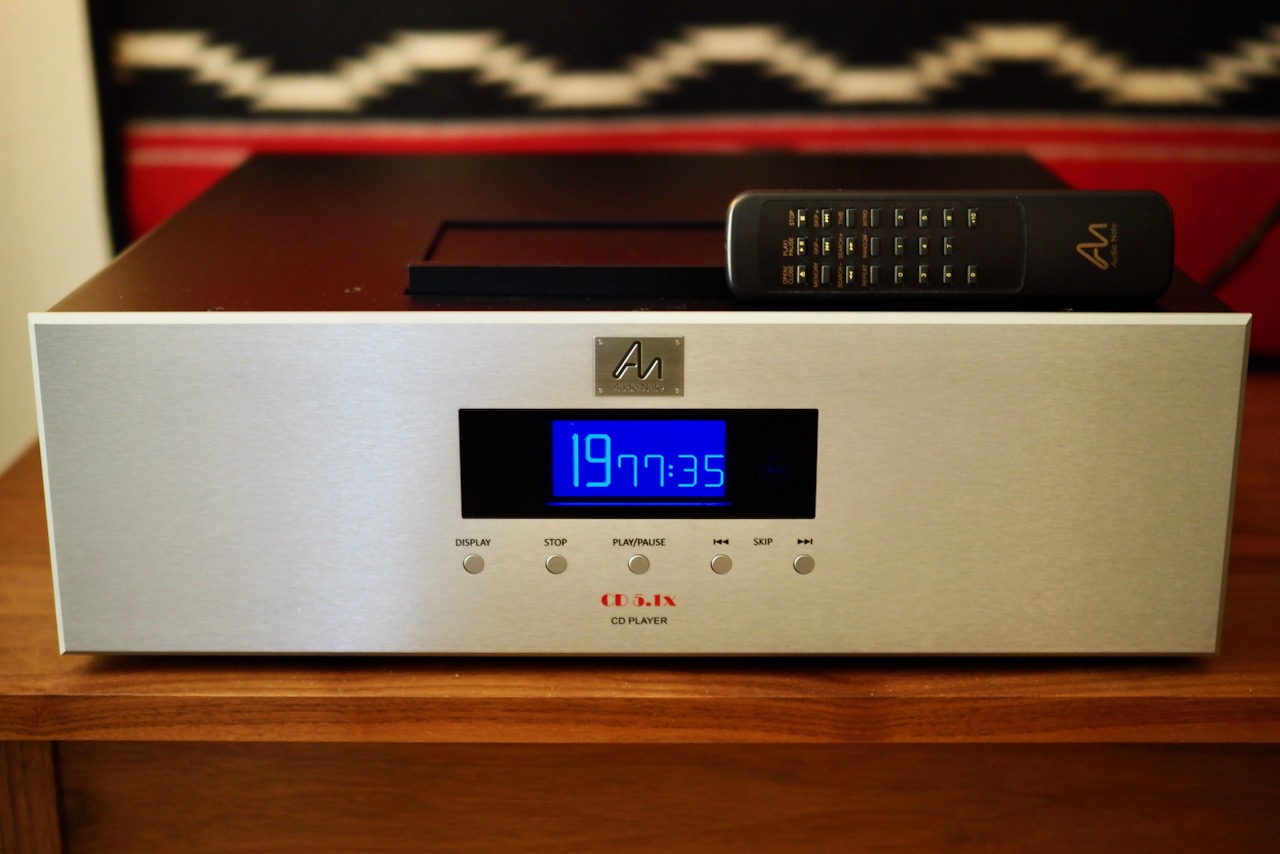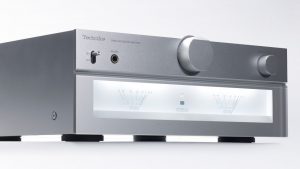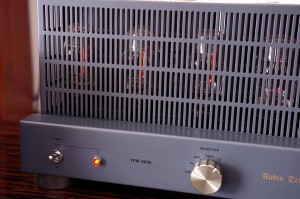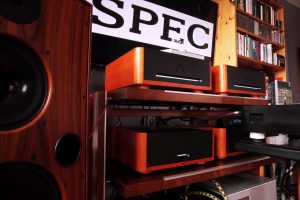Back in October of 2020 I did a straw poll among readers of Jeff's Place and Positive Feedback to find out what audio products they would be most interested in having me write about.
The most popular and intriguing request among readers was the artisanal and custom-made Triode Lab 2A3 EVO single-ended-triode integrated amplifier from Frank Ng in Toronto, Canada (photo below).

2A3 EVO integrated amplifier. Photo courtesy of Triode Lab.
I was not familiar with Frank's Triode Lab designs, but there's nothing I enjoy more than telling you about a new-to-me artisanal audio designer who builds state-of-art audio products, so I contacted Frank to inquire if I might write about one of his Triode Lab 2A3 EVO SET integrated amplifiers for all of you here at Positive Feedback.
Frank was very gracious in his response to my inquiry and told me he would be delighted to have me write about one of his integrated amplifiers for you.
If you go to the Triode Lab website, you'll see that Frank offers a number of EVO integrated amplifier vacuum tube designs so as to best match the varying amplification needs of his customers.

Triode Lab 45 EVO integrated amplifier. Photo courtesy of Triode Lab.
Frank currently builds EVO integrated amplifier designs based on 45,2A3, and EL84 vacuum tubes, which are all vacuum tube types whose performance that I greatly admire.
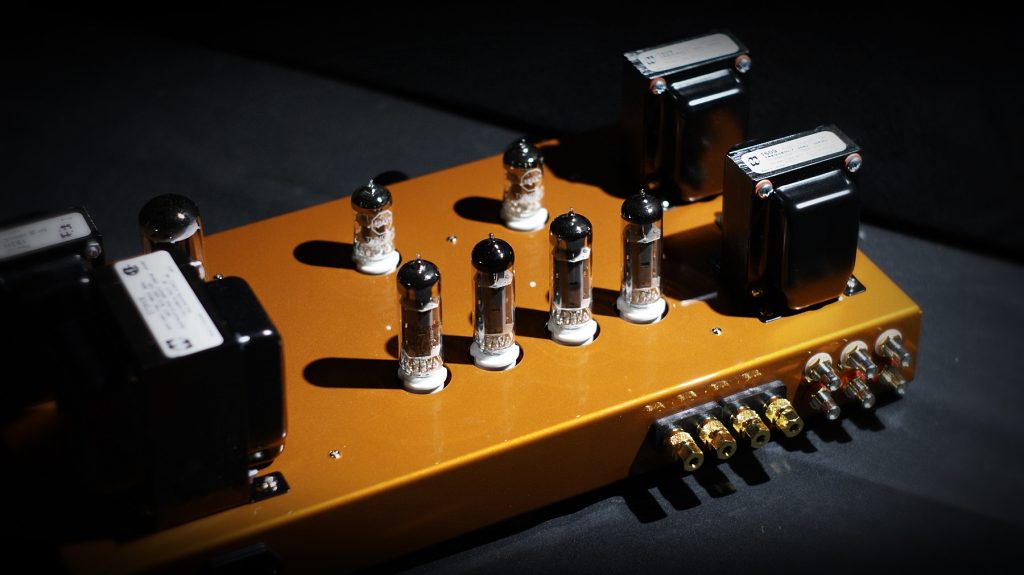
The Triode Lab EL84TT EVO integrated amplifier. Photo courtesy of Triode Lab.
I am a big fan of quality integrated amplifiers, as they can provide a huge slice of state-of-art audio performance at a more accessible price point.
In addition to his EVO integrated amplifiers, Frank also offers separates, including preamplifiers, phono stages, and a number of stereo and monaural amplifiers based on 45, 2A3, EL84, 6V6, and 211 vacuum tubes, which you can read more about on the Triode Lab website.
All of Frank's amplifiers are custom-built to order and are custom-tailored to an individual customer's needs and preferences.
So that I could experience the custom-tailoring process that a Triode Lab customer would experience when ordering one of Frank's EVO integrated amplifiers, Frank suggested that I go through the same sort of custom-tailoring process that you would go through as a customer.
To start the process Frank quizzed me about my loudspeakers and audio preferences to get a better idea of what the most appropriate build and voicing for the amplifier would be.
Frank's first question to me was about the sensitivity of my loudspeakers. Were my loudspeakers above 100dB sensitivity?
I told Frank that I had four pairs of loudspeakers that could potentially be used in the article about his amplifier. Three pairs of my loudspeakers are vintage Altec loudspeakers with sensitivities above 100dB, and I have a pair of Tannoy Westminster Royal SE loudspeakers with a sensitivity of 99dB.
Given the high-sensitivity of my loudspeakers, Frank suggested that I consider writing about the Triode Lab 45 EVO integrated amplifier instead of the 2A3 EVO integrated amplifier, as Frank thought the 45 EVO would perform at an even higher level than the 2A3 EVO with my collection of highly-sensitive loudspeakers.
I appreciated Frank's thoughtful suggestion of steering me towards the 45 EVO for my particular collection of loudspeakers, and I followed Frank's expert advice to get the greatest possible performance benefit out of his custom-tailoring process.
Next Frank asked me questions about the choice of output transformers for voicing the 45 EVO to best match my loudspeakers and personal tastes.
Frank utilizes the highly regarded Hashimoto Electric Co. transformers in his designs, which I might add were also the favorite transformers of the late Don Garber for select Fi designs.
Frank explained to me that Hashimoto output transformers are available in three voicing styles that will make one of them a better match to particular loudspeaker designs and listener preferences: the "Standard", the "Classic", and the "Combo" voicings.
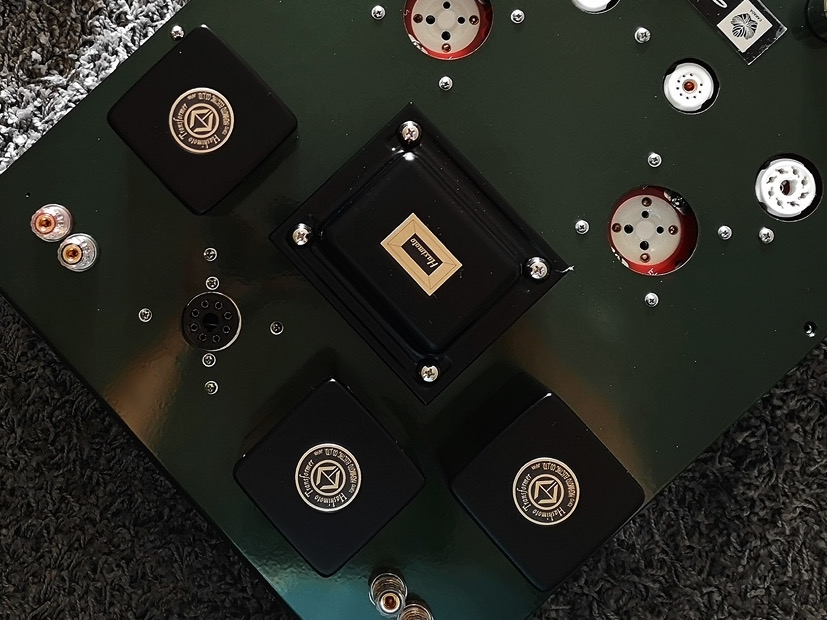
7W Standard Hashimoto potted output transformers. Photo courtesy of Triode Lab.
The Hashimoto "Standard" 7 watt potted output transformer (photo above) provides "… unrestrained highs, high-resolution of recorded nuance, pinpoint imaging, good headroom, and a big sense of space and air, making it the most realistic sounding of Hashimoto transformers … ."
Frank told me, "On smaller speakers, regular dynamic and/or bass reflex box speakers, and some hybrid horn loaded designs, etc., the 7W potted output transformer can be a better match for most of them. There are no absolute rules to matching transformers to loudspeakers, thus I used the word "most", as loudspeaker designs can vary greatly depending on their design. The driver types, the crossover type, their efficiency, the materials of driver, the resistance of the drivers, the type of capacitors, inductors, etc., all yield different outcomes.
"The 7W potted output transformer can be better for certain applications, as when the listener wants to emphasize clean and accurate transient speed, absolute pinpointing imaging, unrestrained highs, sharpness, a 3D soundscape, air and inner details, proper resonances of voices and instruments, etc. It's another kind of beauty. There is no best this, or that, it all comes down to matching, and one's ear. Whichever output transformer type gives the listener more enjoyment wins."
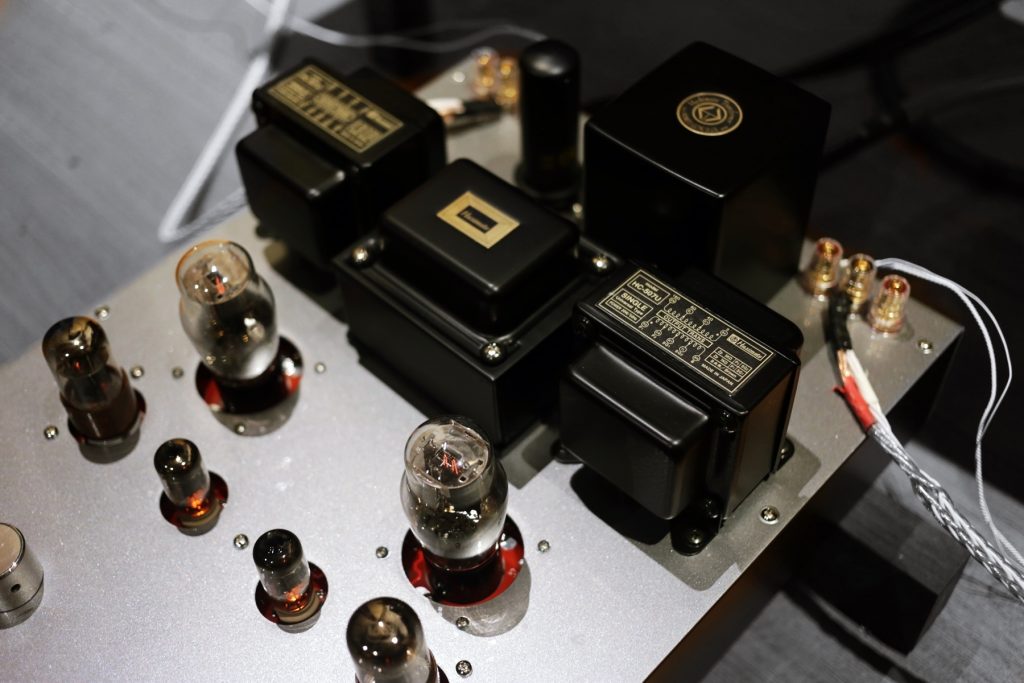
20W Classic Hashimoto output transformers. Photo courtesy of Triode Lab.
The Hashimoto "Classic" 20 watt output transformers (photo above) "… have more meat, impact, musicality, weight, and bass (they are more upfront too). It's at its best with vintage speaker designs and horns."
Frank told me, "The 20W Classic output transformers have a synergy for matching loudspeakers that represent "extreme conditions". Most of the big vintage designs, or highly efficient loudspeakers, fall into this category. Here the 20W Classic output transformers will be very helpful. With better bass extension and better weight, the 20W Classic became very balanced top to bottom. The 7W output transformer's superior high-frequency and mid-range performance can become overly pronounced, especially on horns, which can make them sound too forward, and lacking in coherence.
"If we use the Tannoy Westminster loudspeakers as an example, if we match them with the 7W output transformers they will sound thinner and flat. The energy, liveliness, realism, proper weight and impact, handling capability, will be missing, which means the sense of rhythm, the sense of being there, the emotion, the swing, etc., might have a hard time being delivered thru the loudspeakers."
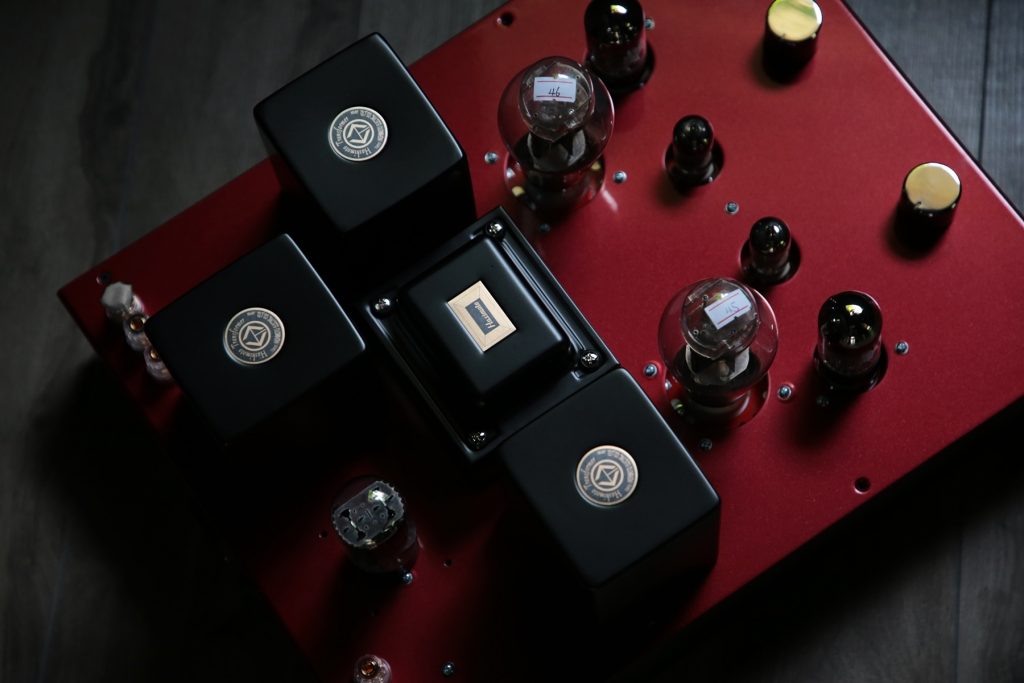
20W Combo Potted Hashimoto output transformers. Photo courtesy of Triode Lab.
The third transformer voicing is "… the bigger, better, more expensive, higher level Hashimoto Combo 20W potted output transformers.
"The 20W Combo combines the best of the 7W Standard and the 20W Classic transformers, and are almost like a hot-rod version of the 7W, with better bass performance. My experience with these three styles of Hashimoto output transformers is that the 20W Combo is too good to the point it could be too analytical and perfect on very revealing speakers. Also, the 20W Combo lacks the poise, grease, and boldness of the 20W Classic version, which could be a benefit for your vintage Altecs.
"On regular loudspeakers, the 20W Combo output transformers will definitely be an upgrade, but for the "extreme case" loudspeakers like the vintage Altecs or Tannoy Westminster loudspeakers, the 20W Classic output transformers will have a more natural flow and richer tone that matches these loudspeakers better.
"So to best match your vintage Altec and Tannoy Westminster loudspeakers, I suggest using the 20W Hashimoto Classic output transformers. It's a safer bet."
Based on Frank's recommendation, we went with the 20W Hashimoto Classic output transformers for the 45 EVO integrated amplifier.
In the next step of the tailoring process, Frank asked me if I would like 4 Ohms, 8 Ohms, or 16 Ohm transformer taps. Given my three pairs of vintage Altecs are all 16 Ohms, and my Tannoy Westminster Royal SEs are 8 Ohms, I opted for taps of 8 Ohms and 16 Ohms.
Frank's final question for me was about vacuum tubes. Did I have a particular set of vacuum tubes I wanted to use?
I told Frank that I didn't have a preferred set of vacuum tubes appropriate for the 45 EVO integrated amplifier, so to go ahead and use a choice of vacuum tubes that he thought would be a good match for my particular application.
I hope this example gives you an idea of Frank's tailored approach to ordering a Triode Lab EVO integrated amplifier, and how Frank recommends components to optimize the performance for a particular customer's needs and tastes.
I was particularly impressed by Frank's thoughtful approach to recommending and voicing the Triode Lab EVO integrated amplifier to meet my particular loudspeaker needs.
If you as a customer have ideas about what might best serve your needs in an EVO integrated amplifier, ask Frank for advice on how well your ideas will work in practice, and Frank can help steer you in a good direction that best matches your needs.
I originally thought that the 2A3 EVO integrated amplifier would best fit my needs, but Frank steered me towards the 45 EVO integrated amplifier for my collection of loudspeakers, and I am glad I listened.
Now allow me introduce you to Frank Ng and Triode Lab.
Frank Ng and Triode Lab
One of my favorite aspects of writing about high-performance audio is telling you about the people behind the designs, so I asked Frank if he would share with us a little about himself, how he got started in audio, and his vision for Triode Lab.
"When asked to give an introduction about myself as the "face behind the brand" I much prefer to introduce my hardworking team, without whom, Triode Lab and Finale Audio would not be possible."
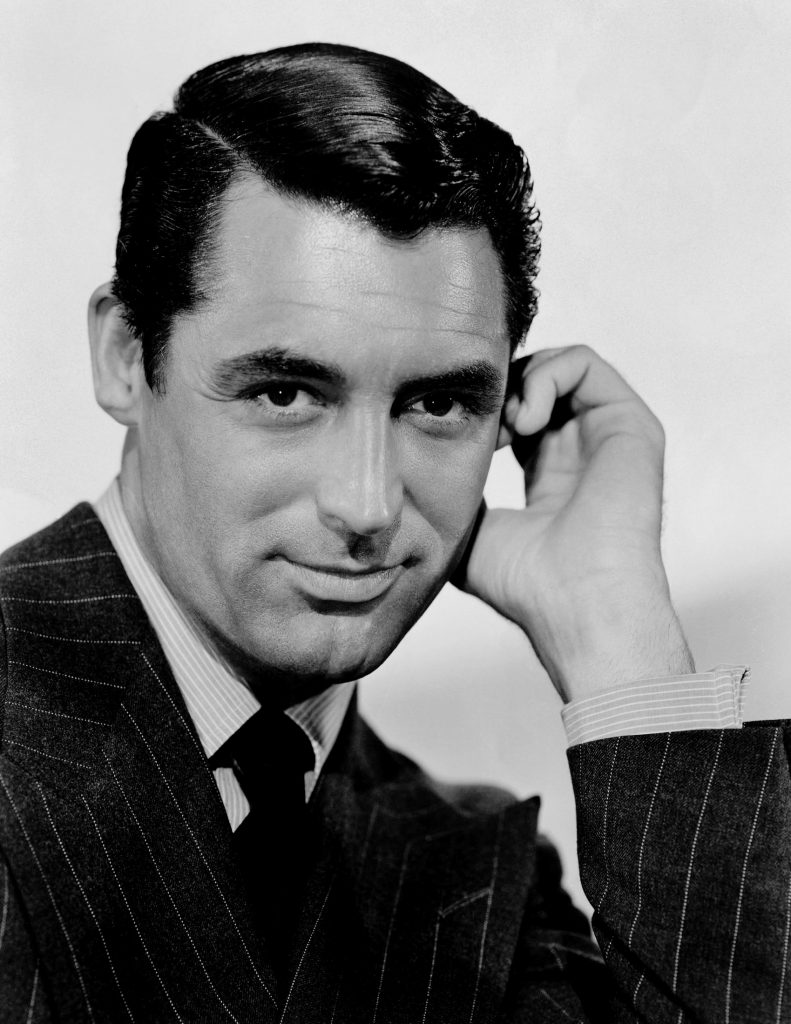
Frank Ng, aka Cary Grant. Public domain photo courtesy of Wikipedia.
(Note: As is my custom, I asked Frank if he would send me a photo of himself so I could introduce him to you, but he was shy and demurring, saying, "I would much appreciate being anonymous because I'm simply not good looking ...". I tried to encourage Frank that was ok, we would appreciate him all the more, as after all, more than a few audio designers are known to look a bit like mad scientists, and indeed, I am actually a mad scientist (albeit a retired one). I substituted a photo of Cary Grant, who is rumored to look very much like Frank. - Jeff)
"Looking back on my humble journey, I have always had more "refined" taste in music than the typical audiophile. As a child, I was very fortunate to be exposed to what "hi-fi" is all about, since many in my social circle of family and friends all had "high-end" audio systems. In fact, even after so many decades, most of these brands are still considered to be top-tier. However, the more I listened, the less these major brands of amplifiers satisfied my needs. Thus, I knew I had to create my own 'standard of sound,' one which I would be proud to share with others someday.
"Now, my 'discerning ears' are not merely a result of listening to countless hi-fi amplifiers on the market, they also come from my music training, as I have been playing piano since the age of 7, along with some guitar and violin.
"Given my background, my first instinct when listening to an amplifier is to consider how real the instruments and vocals sound. For instance, does the piano sound like a digital keyboard, or a violin sound like a viola, because the amp's frequency started to roll off early, or do the guitar chords sound "muddy" and slow? To me, a bad amp is evident when music playback lacks range, while a good amp can always to deliver both staccato and legato, doing great justice to the genuine emotions of the music itself.
"In the early 2000s, a few close friends whose careers are all in the electronics sector (audio and communication engineers, electrical and computer engineers, and industrial designers), and I, decided to get together to make our audio dream happen. We started by designing and manufacturing mass-produced radios, auto and marine amplifiers, toy- and computer-related sound products, custom electronics for radio stations and studios, and even communication electronics for larger vessels and towers. All of us were familiar with and skilled in solid-state designs from the "golden-age era of solid state electronics" from the early 80s and 90s.

"We were also especially fond of triode tubes, due to how realistically they play back the music, so we used our knowledge to launch high-performance vacuum tube amplifiers. Although these designs were not suitable for mass production or profit-making, we still wanted to go ahead because we knew that audiophiles like ourselves would enjoy them.
"The next step involved spending endless hours voicing every amp, fine tuning everything from hardware choices to passive parts values. Each model of a transformer, or even an individual capacitor can sound dramatically different in our circuits. I fondly recall those days where I would often have stimulating discussions and heated debates about various settings for better measurements and specs. Without a doubt, my main objective would always be achieving the best sound.
"Once, for a 45 EVO, I insisted on using 5K primary impedance output transformers (versus the 2.5-3.5K most often used) for a better and livelier sound, lower distortion, improved balance and weight, and more consistent delivery with different 45 tubes (particularly with older and new old stock tubes). In my opinion, the benefits in running 5K primary impedance far outweighs the very minimal wattage loss in returns. Running a lower impedance not only means a flatter and duller sound, but there is also less involvement, dynamics, excitement, harmonics, and tempo.
"Our goal at Triode Lab and Finale Audio was to evolve every vacuum tube design we make to get the best out of today's modern hi-fi equipment and music. This means low distortion, wide band-width frequency, quiet and reliable operation, all for which we are known. Our vacuum tube designs must also measure well with good performance and specifications.
"What's more, given we are playing music with the amp for pleasure, and not for the test bench, so good balance, dynamics and harmonics are all important aspects as well.
"We strive to deliver an audio experience that resembles a 'live' performance. In fact, this is exactly what makes a good hi-fi tube amp, not something that measures perfectly on the test bench but sounds 'dead' when playing music. We want to turn the audio signal into actual music.
(Note: The "EVO" in Triode Lab products nomenclature represents Frank's fondness for exotic sports cars, in this case the Ferrari EVO, and the 45 EVO is painted in actual Ferrari red paint as a tribute. A secondary meaning is the evolution in performance that has occurred with the 45 EVO compared to the best 45 vacuum tube amplifier designs of the past. So by analogy, if a 1920s 45 single-ended-triode amplifier represents an early Ferrari model, then the Triode Lab 45 EVO represents the more "evolved" example that is the Ferrari 488 EVO. - Jeff)
"Despite there being many amplifier applications for different uses like accuracy, or loud volumes, and so on, my team and I specialize in making hi-fi amplifiers that play music well for home applications.
"Professional uses for studios, sound chambers, radio stations, concert halls, stages, or movie theaters entail a different design mindset, so the outcome may not be optimal for home use.
"For instance, tube amps for movie theaters are more likely to be designed in higher power Class AB mode due to heat, efficiency, and prolonged usage concerns. Some audiophiles may not realize each amp's and speaker designs exists for a specific purpose or application.
"For example, take horn speakers: some are used for performing arts, or public address systems for speech, like Klipsch, where they can also be seen on warships and aircraft carriers, and even for presidential speeches. Western Electric and Altecs are common for theaters, communication channels, and for musicals, while JBL and TAD are often designed for home theaters and studios.
"So now, 20 years after the Y2K, many amplifier manufacturers are still using designs from the 50s or 60s, the mono era. We do our best to ensure that each of our designs are totally evolved to meet today's standards in comparison.
"If we must give a name to our sound, we can call it a 'touch of modern hi-fi flavor', or something a bit fancier, like 'Triodeism'. Either way, we pride ourselves in delivering realistic fine audio playback with a hint of the past, but perfect for today's high definition and wide-bandwidth recordings. The amplifiers won't be shy in the bass nor will their highs be rolled off pre-maturely (back in audio history, the bandwidth of sources was narrower). Most of all, the range of variations in music will be presented, providing that sense of being there.
"Today's expectations for reliability and operational noise are at much higher standards than those of the past, so auto-bias for tube amplifiers today is a must.
"When we design an amp, we put the needs of our customers first, and the ease of use of the amplifier for the listener will always be on top of our priority list. We firmly believe this is the best way to connect fine analog music to the end user at home. So, if an amplifier is hard to operate or maintain, then, we have not been successful in our product design, and must go back to the drawing board once again.
"To close, at Triode Lab and Finale Audio, we are not driven by profits. Rather, we are passionate about sharing a better sound experience through our evolution-ized tube designs with higher fidelity.
"Importantly, as a Canadian entrepreneur, I wish to support our local audio industry, and continuously create and promote more opportunities for this trade. All our parts, the most authentic and the best, are sourced through North American distributors, while all the chassis and shipping boxes are made right here in Toronto. Each amp we build is the result of the efforts of about ten different companies, the hands of twenty to thirty Canadians.
"The process is as follows: first, my chassis design sketches are sent to the CNC drafter and designer, then after that step the chassis designs go to half-a-dozen metal workers. After that the chassis go through a quality control inspection, and packing. They are then sent to the painter's shop. Each of our parts distributors are involved, and likely another dozen at Hammond, and, of course, our team at Triode Lab.
"While I'm not earning much money from my audio ventures, I'm still very happy with the outcome because I get to satisfy my passions as an audiophile and music lover, and as an entrepreneur!
"The last two decades or so have been challenging, trying to cope with inexpensive products made offshore. In addition to Triode Lab and Finale Audio, I have also been running my other manufacturing business, which specializes in high-fashion garments, with nearly a hundred hard-working Canadians employed prior the recent Covid-19 pandemic.
"I'm glad we're finally "seeing the light at the end of the tunnel" as many consumers have returned to buying local, or, at least, North American made products. Time has certainly proven that my determination to succeed, and my ongoing efforts, have led to some of the best quality Canadian-made products.
"Last, but not least, I would like to take this opportunity to express my sincerest gratitude to my team of dedicated professionals, for doing exactly what they are good at, and also for helping me in realizing my life dream of building fine audio products. The last ten years have been wonderful, and I look forward to the next ten years of this exciting journey!"
The Triode Lab 45 EVO Single-Ended-Triode Integrated Amplifier
The 45 EVO single-ended-triode integrated SET amplifier's base price is $7500 USD, which includes world-wide shipping, one new set of preferred tubes, and a power cord (HERE) and speaker cables (HERE) produced by Triode Lab.
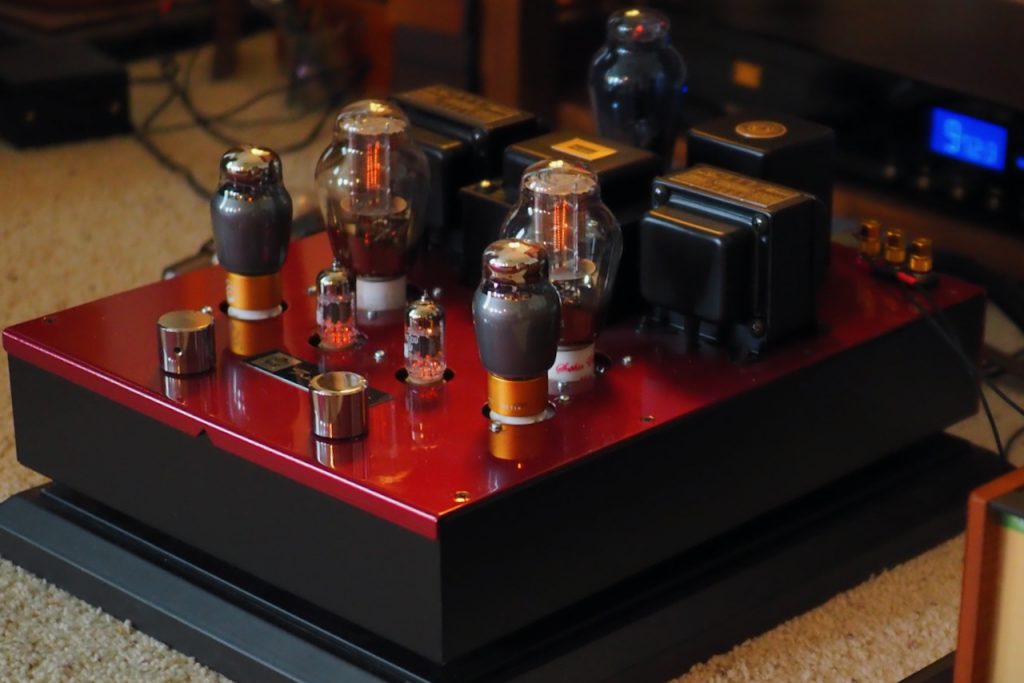
The Triode Lab 45 EVO integrated SET amplifier.
The 45 EVO integrated amplifier in this article also included the optional custom automotive Ferrari Rosso Fiorano paint finish, which is a $1000 USD up-charge, with the total price coming to $8500 USD.
The 45 EVO utilizes a vacuum tube complement of two 12AX7s, two 6SN7s, two 45s, and a single rectifier. A variety of rectifiers can be used in the 45 EVO, such as the GZ32, 5V4, 5T4, 5U4, or 274B, for example. However, I recommend a 274B rectifier for the 45 EVO, as 274B rectifiers provided considerably better performance than any of the other types of rectifiers I tried in the 45 EVO.
The 45 EVO features Class A autobias for 2 watts per channel output. The design of the 45 EVO will allow for the substitution of 2A3s for the 45s to provide 3 watts per channel output for those who wish to experiment.
The parts complement for the Triode Lab 45 EVO integrated amplifier in this article is as follows: Hashimoto Classic output transformers, Hashimoto choke transformer, and Hashimoto 45/2A3 power transformer, QQQ rectifier tube sockets, two pairs of CMC gold-plated RCA inputs, Cardas gold-plated binding posts, Mundorf silver PIO coupling capacitors, an Alps Blue volume control, a Lorlin selector switch, and a Furutech gold-plated IEC AC inlet.
This is Frank's recommended parts complement for the Triode Lab 45 EVO integrated amplifier, along with the Hashimoto Classic output transformers - with 8 Ohm and 16 Ohm taps - that Frank recommended as the best match for my loudspeakers.
The 45 EVO is available in 9 stock colors at no charge, and in custom colors for an up-charge (more information HERE).
The 45 EVO integrated amplifier is also available in a "Reference" configuration starting at $8888 USD. The Reference version of the 45 EVO is equipped with 20W Hashimoto transformers, a large-sized Hashimoto choke transformer; Furutech Type 803, Audio Note (UK) Meishu, or Cardas rhodium binding posts; a DACT selector, Mundorf supreme EVO silver and gold coupling caps, a Furutech rhodium AC inlet (or optionally gold), and an automotive paint finish (like the custom Ferrari Rosso Fiorano paint finish on the 45 EVO in this article).
Given that the 45 EVO parts complement is customizable based on a particular customer's specialized needs or desires, I recommend that you discuss any options you are considering with Frank to make sure it is a good match for your intended purpose.
I asked Frank if he would share with us some more detail about his design of the Triode Lab 45 EVO single-ended-triode integrated amplifier.
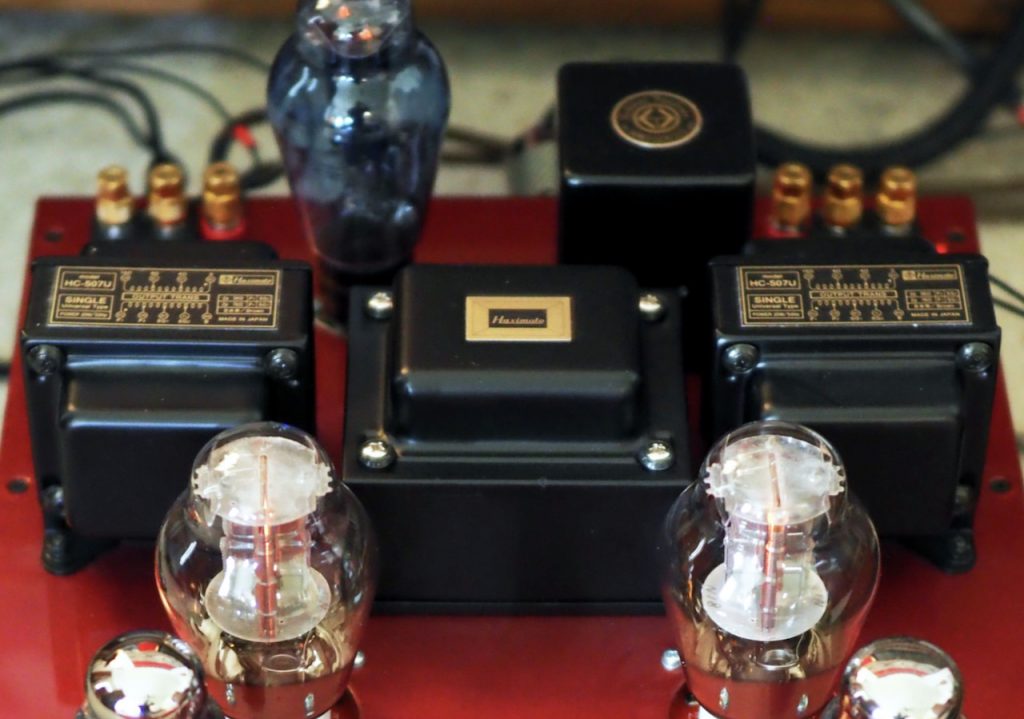
"First, we want our designs to have the best transformers available, which are the Hashimoto Electric Co., Ltd, transformers (Hashimoto has been making transformers since 1958, and you can read more about their history HERE - Jeff)."
"Many audio enthusiasts already know that without good transformers, the SET amp they are listening to cannot be at its best, as the ability to unleash the full performance of a circuit and the vacuum tubes is dependent upon the transformers used."
"Transformers are like the transmissions of race cars. You can have a very fast engine, but to deliver the full potential of the engine the transmission must be a good match to the characteristics of the engine."
"The same principle applies to a vacuum tube amplifier, particularly SET designs. Good transformers allows for better highs and lows, and maintains the power output. A lot of mass produced tube amps do not make their claimed power due to the insert loss of their average grade output transformers, as well premature distortion. Also, the ability to give listener the realistic rhythm and coherence thru good dynamics and harmonics depends on the quality of the transformers. Without the full highs, lows, power output, dynamics, and harmonics, the playback can sound dull and un-involving, flat and un-lively, and sound like an unrealistic "mock-up" of the music."
"Throughout the years there have been plenty of high-end transformer companies. Over the last few years most of them have closed or have stopped production, as the demand for high-quality transformers for vacuum tube amplifiers is at an all-time low, and transformers are challenging to make, and the cost of making them is high.
"I spoke with a few managers of these high-end transformer companies. They explained that finding skilled labour is a big challenge for them, as there are few people who know how to design quality hifi transformers anymore, and fewer who can wind and produce them. Also, the stricter environmental laws mean that companies would have to spend a lot of money for cleaner machinery and production facilities to produce low volumes of transformers, making it financially prohibitive."
"Fortunately, Hashimoto Electric Co. in Tokyo are real experts in designing and manufacturing high-quality transformers for vacuum tube amplifiers. We have had experience with Hashimoto transformers for decades, and they are one of the few real experts in tube transformer design that still exist today, and are my preferred choice for transformers."
"There are some companies offering transformers with incredible specifications for wider bandwidth, or that are made from rare materials, but there is more to transformer performance than just impressive numbers. Playing music well also requires transformers to have good balance, with dynamics and harmonics that gives the music a real or life-like feeling, so that it can deliver a sense of musical authenticity to the listener, that "being there" feeling."
"So designing transformers that provide good music playback that is involving emotionally and enjoyable over the long haul is not just about specifications numbers, it starts at the very beginning of the design process with designers that know how music sounds in the first place, versus just looking at performance graphs. In short, the design and production of quality hifi transformers is becoming a lost art."
"Using the car analogy again, a car that can only go fast in a straight line doesn't make it the best car. A car that is fast and also has good handling in the corners, and is built with quality, refinement, reliability, and charisma in mind, will be the better car, and have the ability to become a future classic."
"Hashimoto transformers are like that. They give you the best balanced transformer package for music, along with the Japanese excellence of craftsmanship and reliability. Hashimoto made the transformers for the old Sansui receivers, and even after half a century many are working fine today, proving their quality and reliability."
"Lets talk about other factors that have shaped the design of the 45 EVO."
"For many years, low-efficiency loudspeakers dominated the market. Now, twenty years after the second millennium of Y2K, high-efficiency loudspeakers have made a comeback. Horns, full-range drivers, coaxial, dual-concentric, and more dynamic boxed speakers with high-efficiency are being made today."
"Many consider the 2A3 to have a very low wattage output. However, with a well built 2A3 amp it can have too much power for some high-efficiency loudspeaker applications. The volume can crank up high too early, with anywhere from 3.5W to over 5W (before distortion starts to kick in)."
"The power rating depends on both the circuit setup and the output transformer, as every single output transformer has different insertion losses and other technical parameters. Subjectively, some transformers have more bass and "meat", and some will have better highs, or a more free-flowing sound, etc. They will all measure differently in terms of output power on the same circuit. With not so well-designed 2A3 amps, we've seen and measured just 1.5W of output power before distortion and noisy operation kicks in."
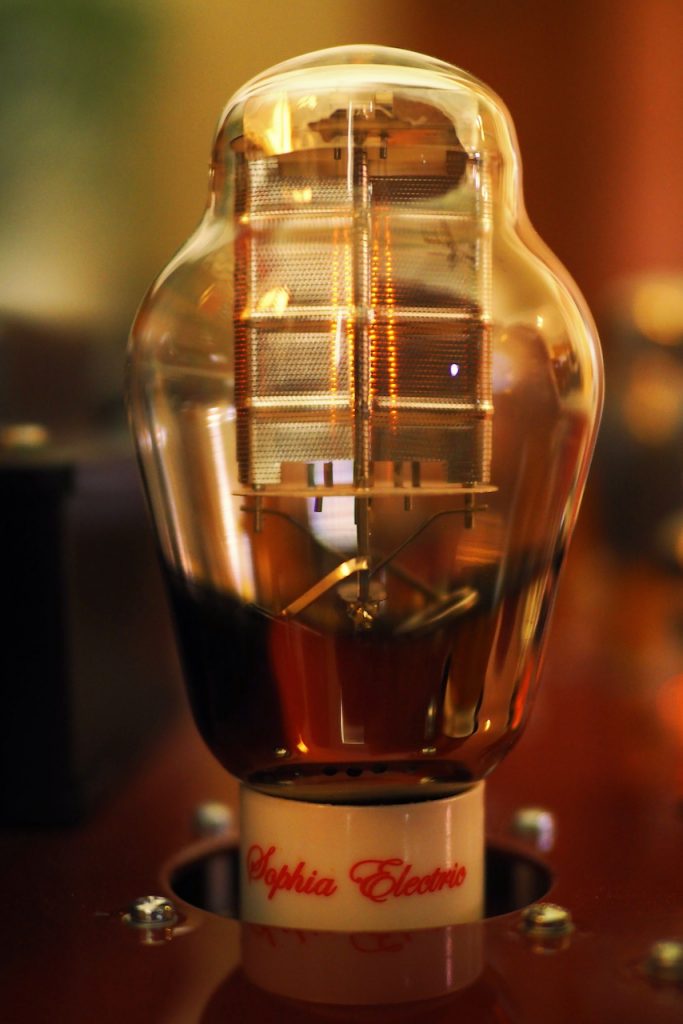
"The 45 became the perfect solution for that all-important first watt in playing music, with the second watt doing the rest (above). Both watts are crucial, speaking from a quality perspective. The 45 triode became the natural choice, being durable, offering lower distortion, and making it easier to achieve a wide bandwidth frequency response, which contributes a 'live like' sound quality. The 2A3 is a cousin of the 45, but it is a totally different tube, and needs a different parts complement to unleash its full potential."
"Are triode tubes the answer for everything? Like everything else, triodes have their limitations. In the case of these ancient triode tubes that were born in the 20-30s, they have very low-efficiency. So when we design around with these triode tubes, we need to make sure to use preamp tubes that have a good enough voltage range to drive them. Although, these triodes are on the lower side of efficiency compared to newer and other types of power tubes, there are still many choices of tubes to use as the driver, and the 6SN7 / CV181 is one of them. We like the 6SN7 / CV181 very much with its good-ole tube sound and flavor, over the more controlled and quieter 9-pin preamp tubes. The 9-pin preamp tubes are sometimes too "perfect" or synthetic sounding for tube connoisseurs. Like the triode tubes, the 6SN7 is also a very rugged and durable tube. Getting a quiet 6SN7 is difficult today. Recently we bought 10 new premium versions of 6SN7s, and 6 of them we tested were microphonic, and we had to send back."
"Now, with the 6SN7 driving the 45, it already makes for a very good power amp combo, but you still can't hook a source up to it directly and expect to get the kind of performance we want to achieve. It could provide enough volume or gain, but would not have enough signal sensitivity to recreate the realistic dynamics and harmonics of the music."
"The control would be lacking with just the 6SN7 driving the 45 triode. Imagine that for all types of loudspeakers, with all types of efficiency, with all types of materials, and with all types of presentations, that some will require more control than others. A good amp design must cover as many loudspeakers as it sees in reality, both in sound quality and and in its ability to control them. Without an extra stage of preamplification in the front end, this amplifier will sound slower and not have enough gain for line-level sources to have proper volume."

"That is why we use two 12AX7 (our design reference) or 12AU7 in the front end. While one 6SN7 would be enough for driving both channels, adding the 12AX7/12AU7 gives better control, better channel separation, and a better cross-talk ratio as well. No money is spared to achieve the best design."
"With all these concepts and goals implemented into the design of the 45 EVO, it's a true reference grade integrated amplifier. A real high-quality tube amplifier needs to sound good and measure well."
"The more technical aspects of the circuit are that the driver uses an SRPP type design, and the front-end stage uses RC coupling for lowest loss (more Class A), better design efficiency, and to more easily control optimal outcomes. We wanted wide bandwidth over high gain, since higher gain means less wide bandwidth. The design also incorporates auto-bias, which absorbs and works with fluctuations from the external power supply, which affects the operation voltage point in the circuit itself. The auto-bias also helps stabilize the operation at start-up during the warm-up period, making the playback more consistent and focused. Even after the amplifier is warmed up, auto-bias makes the sound signature of the amplifier more consistent, always giving the same sound quality in listening sessions. Last but not least, as the vacuum tubes age, and cannot maintain their specifications and voltage, this approach provides more safety and reliability."
"All of these technical notes aside, let me say that while the Triode Lab 45 EVO is a reference-level single-ended-triode design in its performance, it is also a very reliable and user-friendly design, which is a priority for us. Ease-of-use, maintenance-free operation as vacuum tubes age, and long-term reliability are all aided by autobias in the 45 EVO, delivering to the owner more long-term satisfaction."
Review Systems
Over the time period that I've had the Triode Lab 45 EVO single-ended-triode integrated amplifier here, I've listened to it in three different audio system contexts.
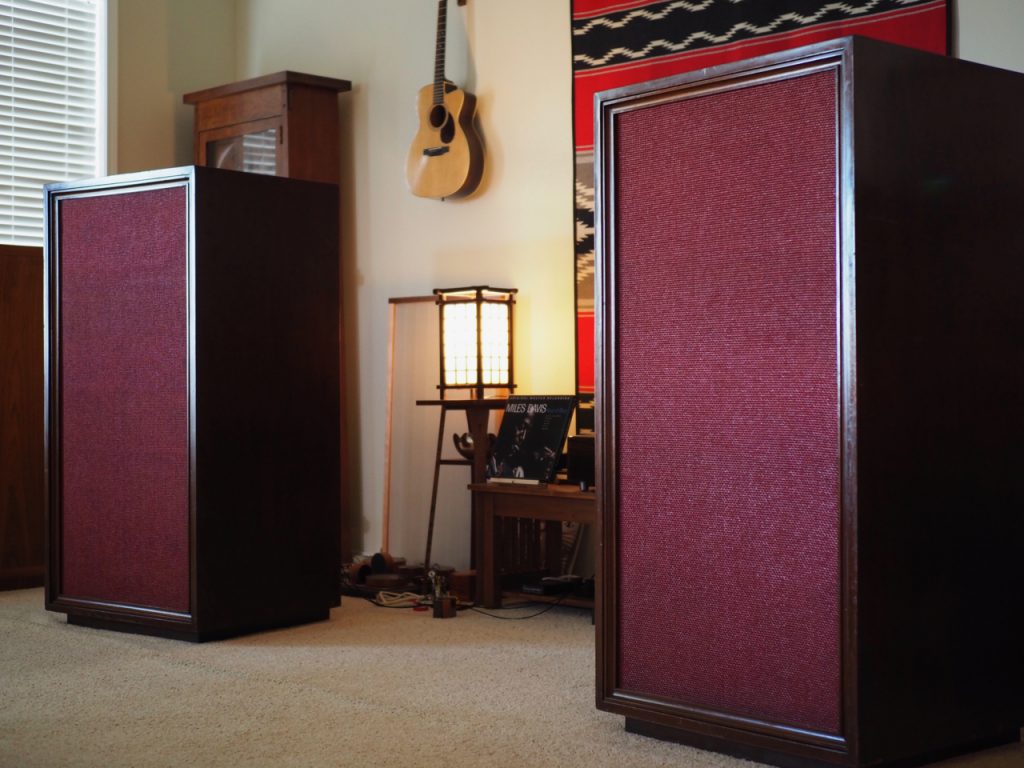
Vintage custom Altec loudspeakers built for conductor Leopold Stokowski.
The first system being my vintage Altec loudspeakers that were custom built for conductor Leopold Stokowski back in the early 1960s, and which were updated with custom Duelund CAST tinned-copper crossovers developed by Frederik Carøe (Duelund Coherent Audio) and myself for the Duelund-Altec Project (HERE).
The combination of the 45 EVO with the highly-sensitive Duelund-Altec Project "Stokowski" Altec loudspeakers provided extraordinary results, and delivered a classic "goosebumps" listening experience that both thrilled and amazed me during listening sessions.
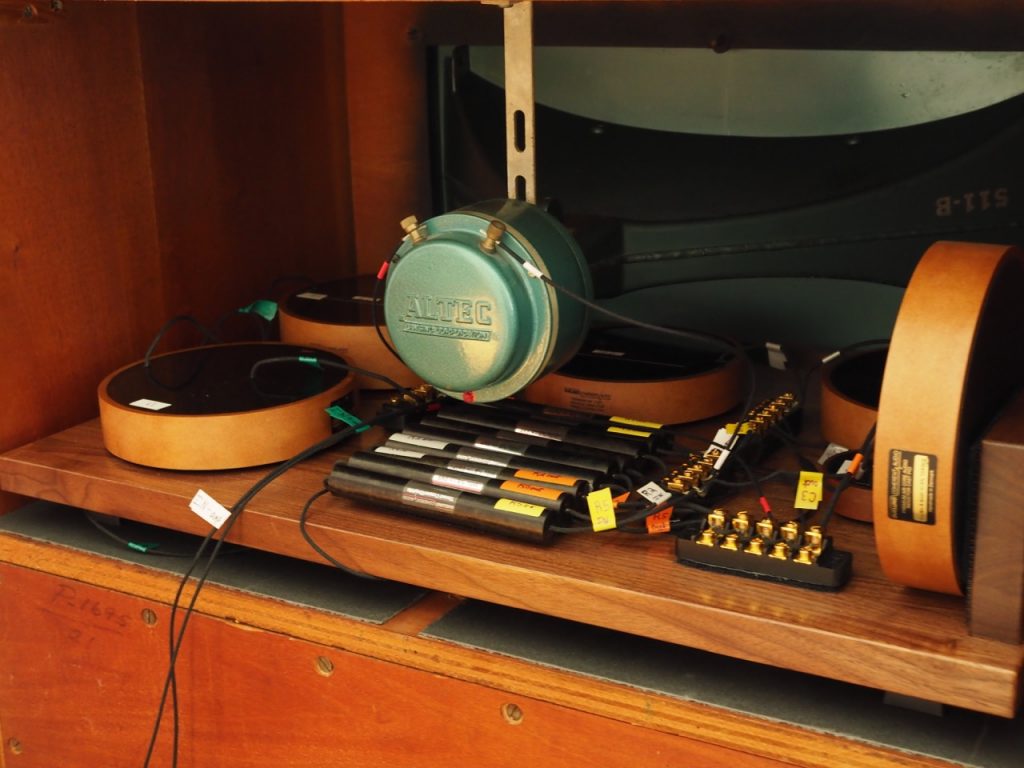
Duelund CAST tinned-copper crossovers in the "Stokowski" Altec loudspeakers.
I then listened to the 45 EVO with my vintage Altec A5 Voice of the Theatre loudspeakers in my audio-visual system (below), and I again experienced that combination of highly-sensitive loudspeakers and 45 SET amplification that made watching videos an exciting, engrossing, and immersive experience.

Triode Lab 45 EVO SET integrated amplifier with Altec A5 Voice of the Theatre loudspeakers.
There's something really special and visceral about an SET and Altec A5 video experience, and it hearkened me back to the days of my youth, when the small-town American movie theaters still used Altec A5 loudspeakers powered by Western Electric 91-A amplifiers.
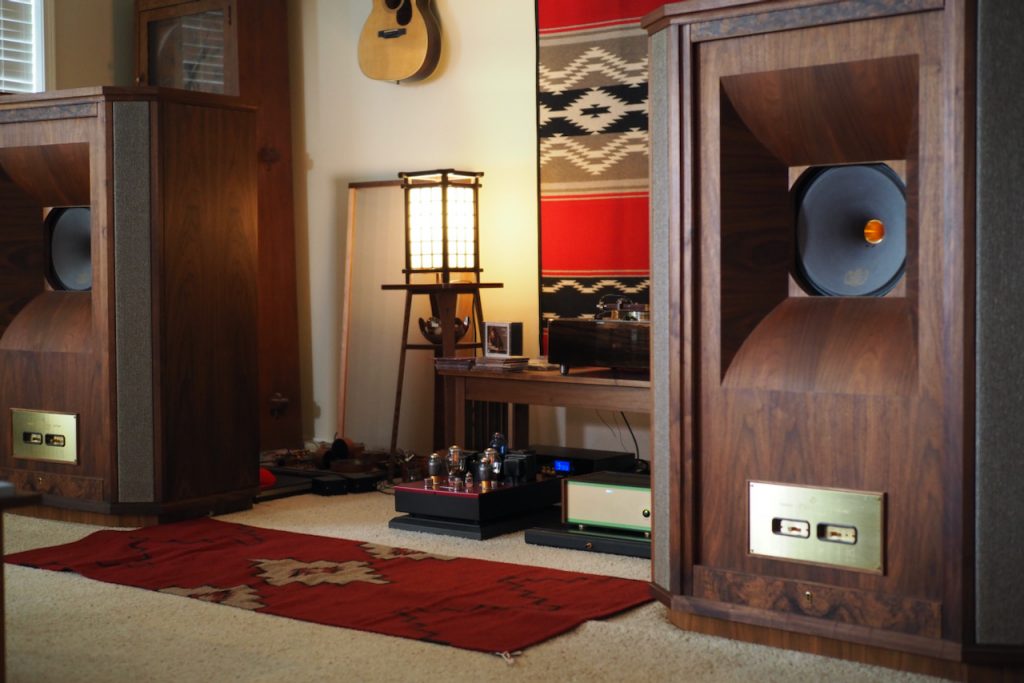
Westminsters powered by the Triode Lab 45 EVO SET integrated amplifier.
Finally, I listened to the Triode Lab 45 EVO SET integrated amplifier in my main music system with my Duelund-ized Tannoy Westminster Royal SE loudspeakers (below), and all of my listening impressions described below are from that system context.
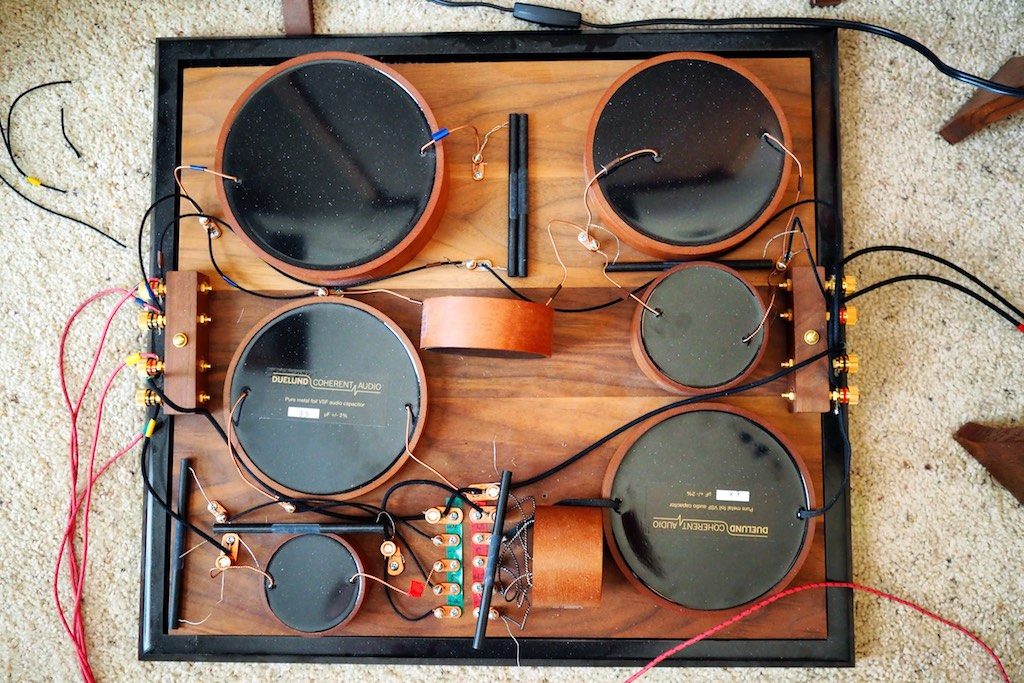
Duelund CAST crossover for Tannoy Westminster loudspeaker.
As Tannoy Westminster Royal SE loudspeakers owners' will tell you, the high-frequency horn of the 15-inch dual concentric driver is extremely revealing, which is why they are used by a number of electronics designers for evaluating their amplifier designs (e.g. Nelson Pass and Wayne Colburn of Pass Labs and First Watt fame both use Tannoy 15-inch dual concentric drivers in custom cabinets for evaluating new designs).
I might also add that the Duelund CAST crossovers (above) of my Westminsters use pure silver Duelund CAST capacitors in the high-frequency circuit, which are extremely revealing, giving a very clear view into upstream components' performance.
For an analog source I used my Classic Turntable Company hot-rodded Garrard 301 in an Artisan Fidelity plinth (below).

All of my listening impressions were with my Thomas Schick tonearm mounted with an Audio Note (UK) Io I moving-coil phonograph cartridge (photo below), which I'll be writing a Positive Feedback feature review about in the not too distant future.

Audio Note (UK) Io I moving coil phonograph cartridge.
If you read my review of Pass Labs XP-17 phono equalizer (HERE) you can get a preview of sorts of the performance of the Audio Note (UK) Io I moving-coil cartridge—it is superb.
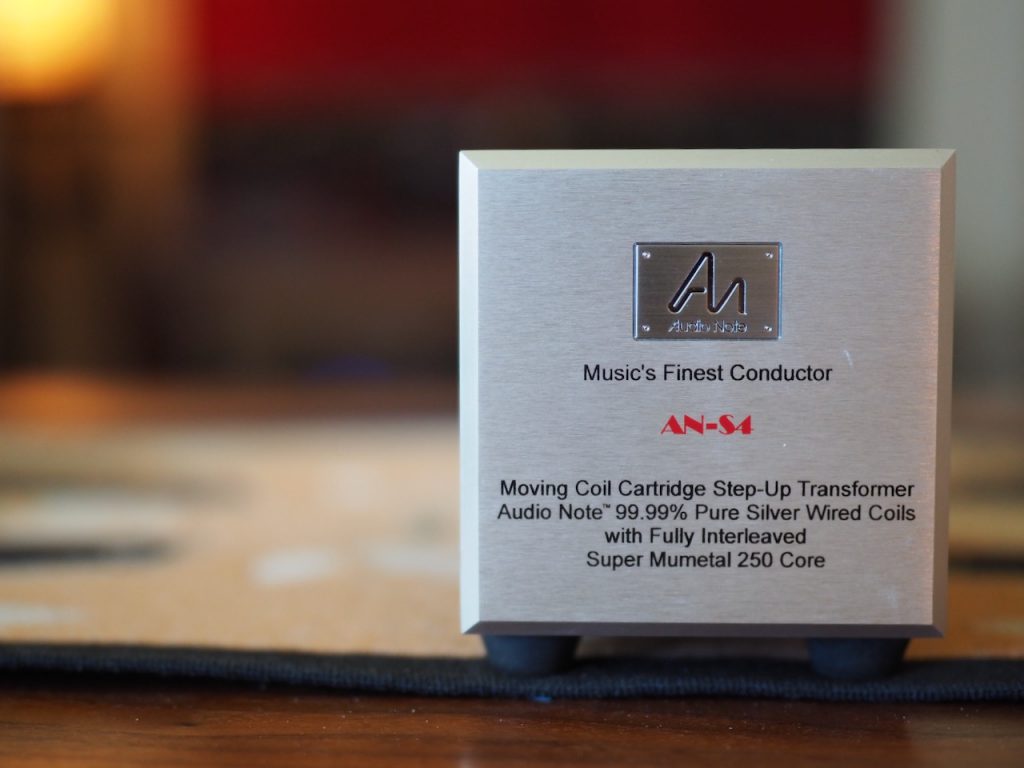
Audio Note (UK) AN-S4 step-up transformer (SUT).
The Audio Note (UK) Io I moving-coil phonograph cartridge was stepped up with an Audio Note (UK) AN-S4 step-up transformer (SUT)—review to come (photo above).
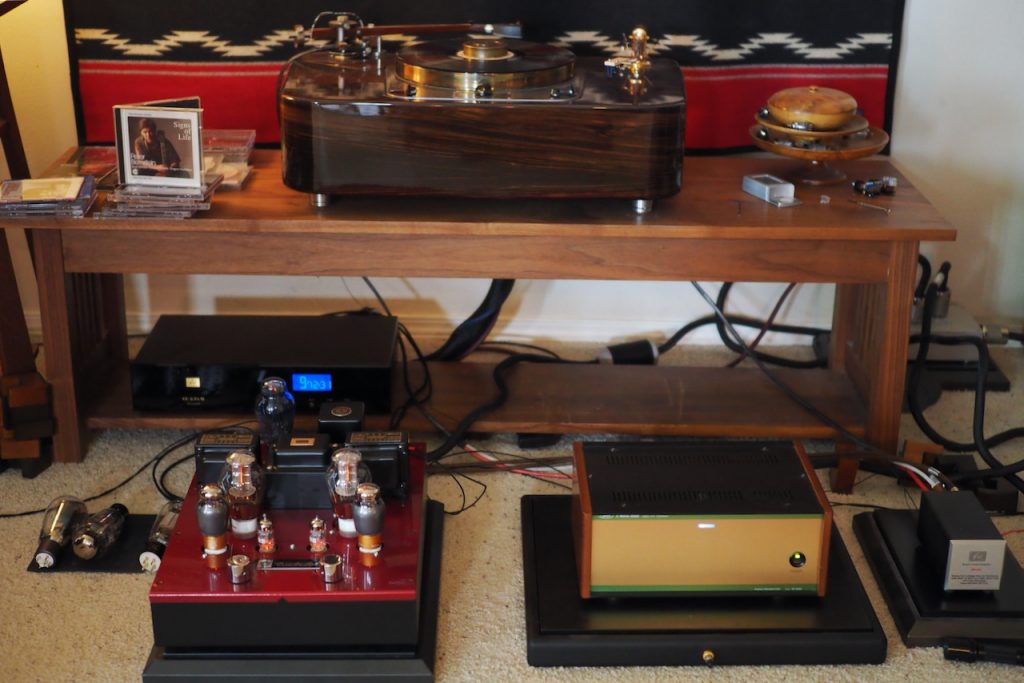
Triode Lab 45 EVO SET integrated amplifier (left), Audio Note (UK) CD (back middle), Leben RS-30EQ (middle right), and Audio Note (UK) AN-S4 step-up transformer (right).
Phono equalization was performed by the Leben RS-30EQ. To connect the AN-S4 SUT to the Leben RS30-EQ, and the RS-30EQ to the Triode Lab 45 EVO integrated amplifier, I used the shielded Belden 8402 tinned-copper microphone cable interconnects, which are longtime favorites of mine, due to their exquisitely balanced musicality and sonic prowess.

I used the superb Audio Note (UK) CD 2.1x/II Level Two Red Book CD player as a digital source (review HERE), along with Duelund DCA16GA tinned-copper interconnects terminated with plastic-free Duelund RCAs - a particularly synergistic match - to connect it to the Triode Lab 45 EVO integrated amplifier.
The power cords used for the Leben RS-30EQ and the Triode Lab 45 EVO SET integrated amplifier were the Acoustic Revive 'Absolute' power cords, and for the Audio Note (UK) CD 2.1x/II Level Two Red Book CD player I used a Sablon Audio 'Robusto' power cord.
To connect the Triode Lab 45 EVO SET integrated amplifier to my Duelund-Westminster Project (HERE) Tannoy Westminster Royal SE loudspeakers I used Duelund DCA16GA tinned-copper speaker cables.
General Impressions of the Triode Lab 45 EVO Single-Ended-Triode integrated Amplifier
Before I delve into album listening impressions to discuss specific performance aspects of the Triode Lab 45 EVO single-ended-triode integrated amplifier, let me mention some of my general observations about my time with the 45 EVO.
First of all, Frank's recommendations for tailoring the performance of the 45 EVO integrated amplifier to match my vintage Altec and Tannoy Westminster SE loudspeakers were spot on, and the 45 EVO has proved to be a very synergistic match to my eclectic collection of high-sensitivity loudspeakers.
As Frank stated in his description, "Each model of a transformer, or even an individual capacitor can sound dramatically different in our circuits," so it should come as no surprise that vacuum tube choices can also make a dramatic difference in the voicing of the 45 EVO integrated amplifier.
That means, that if you wish, you can further tailor the voicing of your optimized 45 EVO integrated amplifier to your listening tastes by your choice of vacuum tubes.
The 45 EVO utilizes a vacuum tube complement of two 12AX7s (or 12AU7s if lower gain is desired, as in the above photo), two 6SN7s (below), two 45s, and a single rectifier.>
A variety of rectifiers can be used in the 45 EVO, such as the GZ32, 5V4, 5T4, 5U4, or 274B, for example.
I tried a number of highly regarded rectifier types from my collection in the 45 EVO, and none of them came close to 274B rectifiers (photo of Sophia Electric Aqua 274B below) for providing a well-balanced, natural, and realistic sounding presentation of the music.
Then there's the 45 triode tubes. You can use NOS 45 triodes, which are getting harder to come by these days, or new production 45 triodes.
I don't have any NOS 45s around anymore to compare directly to, but compared to my recollection of what my stable of NOS 45s sounded like in my Wavelength 45 monaural amplifiers, the new production 45 tubes don't sound much like my NOS 45s did (although some more than others, like the Sophia Electric 45 mesh plate in the photo below), although they do sound quite good in their own right.
The tube complement for the 45 EVO that I settled on for this article was a pair of Genalex Gold Lion 12AU7s, a pair of Psvane CV181-TII (6SN7s), a pair of Sophia Electric mesh plate 45s, and a Sophia Electric Aqua 274B rectifier.
If you are interested in more details about the 45 and 274B vacuum tubes I chose for this article, you can read more about that HERE.
Perhaps the aspect of the Triode Lab 45 EVO integrated amplifier's performance that surprised me the most was its ease in driving my Tannoy Westminster SE loudspeakers to live-like volume levels.
In the past I haven't had particularly good results driving my Westminsters with amplifiers of less than about 25 to 30 watts of power. The Triode Lab 45 EVO really caught me by surprise with how well it could drive the West's with its 2 watts of output power, and the 45 EVO's 'drive-ability' has bettered some of the amplifiers I have tried with ten times its power output.
To achieve live-like levels with the West's, it meant that the volume pot of the Triode Lab 45 EVO was 80 - 90% open when playing most program material, with the digital and analog sources I used for this article.
Only on an occasional softly recorded album with big dynamic peaks did I feel a need to run the Triode Lab 45 EVO wide open. Even then I didn't really hear it running out of power, or clipping, or doing anything nasty. Rather, it remained composed and unruffled with whatever I was listening to.
On my 100+ dB sensitivity vintage "Stokowski" Altecs, or my vintage Altec A5 Voice of the Theatre loudspeakers in my audio-video system, the 2 Watts output of the Triode Lab 45 EVO integrated amplifier easily powered them to live-like levels, with room to spare.
You wouldn't think that the Triode Lab 45 EVO integrated amplifier would have good bass response with its 2 watts of power driving 15-inch low-frequency drivers, and it didn't, it had great bass response. In fact, the 45 EVO had the most well-integrated, articulate, tuneful, and realistic bass response of any amplifier I've tried with the Westminsters. Truly superb.
Listening Impressions
Let's listen to some albums for some more specific examples of the performance of the Triode Lab 45 EVO single-ended-triode integrated amplifier.
It turns out that only a small fraction of the greatest musical performances ever recorded are represented by the sort of albums marketed to audiophiles. The recordings that audiophiles predominantly listen to represent less than 1% of our recorded music canon, and if one only listens to those recordings one misses a lot of the greatest performances of music ever recorded.
We are blessed that the often unheralded heroes of the recording arts have documented musical performances for us from the very first known recording of April 9, 1860, when French luminary Édouard-Léon Scott de Martinville recorded Au Clair de la Lune on the phonautograph he invented and patented, until now, with the sophisticated recording capabilities of the present day.
Music is central to our human experience and is believed to have evolved about 40,000 years ago. Until April 9, 1860, if you wanted to listen to music you listened to live performances of music. Then on that pivotal day in April of 1860, something magnificent happened, a recording of music was created that documented Au Clair de la Lune, which ended up changing how we appreciated and documented performances of music forever.
Humanity's entire recorded music canon - from the very first recording to the most recent one - is of enormous historic importance to the musical arts specifically, and to world culture and civilization broadly. Music is part of who we are at a very fundamental level.
It can be an immensely gratifying experience to become more familiar with all of the parts of our musical history and legacy, as a well-rounded person who appreciates music, history, and the rich cultural achievements contributed by our fellow citizens on Planet Earth.
Very generally speaking, the history of the music recording arts can be divided into the acoustic era (1860 to 1925), the electrical era (1925 to 1945), the magnetic era (1945 to 1975), and the digital era (1975 to the present).
While many of the albums marketed to audiophiles are from the magnetic era, there are a lot of important musical performances from the acoustic and electric eras of recordings that make for truly enjoyable listening, and that you'll want to hear to be a well-rounded music lover.
It turns out that not all audio equipment is designed to be able to play back those early recordings in a satisfying way. If, for example, an audio equipment design is optimized to play back only the best recordings from the magnetic recording era, it shouldn't be too surprising that particular equipment will crash and burn when playing back recordings from the acoustic and electrical eras of recording.
Why? Generally speaking, in enthusiast audio, we are looking at the voicing of audio equipment over an auditory range that spans human hearing, from about 20Hz up to about 20,000Hz. That frequency range can be broken down into bands of frequency of the sub-bass (20-60Hz), the bass (60-250Hz), the lower midrange (250-500Hz), the midrange (500-2000Hz), the upper midrange (2000-4000Hz), the presence region (4000-6000Hz), and the brilliance region (6000 to 20,000 Hz).
Audio equipment voiced only with the best recordings from the magnetic era can have a subtle, or not so subtle, emphasis in the midrange (500-2000Hz), upper midrange (2000-4000Hz), presence region (4000-6000Hz), and brilliance region (6000 to 20,000 Hz), that gives the best recordings from the magnetic era of recording an 'audio spectacular' sort of presentation, but limits the ability to enjoyably listen to music from earlier recording eras, or the many 'average' recordings from the magnetic and digital eras of recording.
Personally, I want to listen to audio equipment designed to play back the entirety of our recorded music canon in high-fidelity, and not just that 1% of the best recordings from the magnetic era.
Given that, an important measure of performance for me these days as I explore our entire recorded music canon is how well a component plays recordings from early in our recorded music canon, from the acoustic era of sound recording (1860 to 1925), for example.
Photo courtesy of the Library of Congress.
Does the Triode Lab 45 EVO integrated amplifier allow the full emotional impact of the music to come through in these early recordings, or are the limitations of early acoustic recordings presented as being so intrusive that one can't enjoy those important recordings of early musical performances?
I just purchased a copy of The Caruso Edition, Volume I 1902-1908, which is on the now defunct (sadly) Pearl record label that specialized in historic recordings.
Enrico Caruso (1873 to 1921) is considered to be one of the greatest - if not the greatest - operatic tenors that ever lived, and if you want to hear him sing, the music comes from the acoustic era of recording.
To quote the liner notes, "Singing, and especially such singing as Caruso's, goes to the heart or it is nothing."
That's my take on audio equipment too, if it can deliver music to the heart it is worthy of our serious consideration, and if it can't, it is not.
Through the Triode Lab 45 EVO integrated amplifier, The Caruso Edition, Volume I 1902-1908, absolutely thrilled me. Caruso's singing was transcendent, and the limitations of acoustic era recordings did not dull at all how amazing he was as a tenor.
The Triode Lab 45 EVO handled the surface noise aspect of these ancient acoustic recordings extremely well, and presented it in such a way that it was in a different dimension from the music, in an analogous sort of way that you can hear tape hiss during the magnetic recording era on albums, but it doesn't intrude on one's enjoyment of the music performances.
In a few short moments I found myself focusing on the amazing musical performances of Caruso singing to me out of the past, not distracted by the limitations of the recordings from the acoustic era, but definitely noticing the goose bumps Caruso's singing gave me, courtesy of the Triode Lab 45 EVO integrated amplifier, which did an extremely good job of providing me an enjoyable time travel experience back to the recording sessions of 1902-1908 in Milan.
The Triode Lab 45 EVO integrated amplifier did an exquisite job of delivering the music to my heart, and it did so in spectacular fashion. I was very, very, impressed with the result. In fact, as I was writing this article, I was so entranced with what I was hearing, I put my laptop down and listened to all three of the discs in this set marathon-style. Incredible music brought to life. Wow. Just wow.
That sort of listening experience is what our wonderful audio hobby is about for me, being able to experience great music from the different recording eras of our recorded music canon, in high-fidelity.
Each Thursday my friend David Gitlen—a superb jazz guitarist—stops by to teach me a jazz guitar lesson, and afterwards we sip espressos and listen to jazz albums.
It's a truly enjoyable time of learning, playing guitars, engaging in illuminating conversations, and of course, just having fun listening to albums.
David has heard many of the great jazz guitarists play live many times, and has played and studied with a few of the greats like Jim Hall and Joe Pass, for example, and has been present for recording sessions of some of Jim Hall's albums as well.
David has lived and played jazz guitar at the center of jazz guitar culture for about five decades, and has many fascinating insights to share about the people, the music, the techniques, the guitars, and the culture surrounding jazz guitarists.
Not only is David an exceptional jazz guitarist, he's also a historian of jazz guitar, which makes our weekly get-togethers particularly interesting and illuminating.
David brings over a jazz guitar album each week, we listen to it, and David explains to me what the guitarist is doing technique-wise, demonstrates techniques to me by playing along with the songs so I can see—as well as hear—what they are doing, and tells me fascinating details about the guitarists, the recording sessions, and all those little details that brings the guitarists and their music to life. Yeah, it's a really cool time!
One Thursday David brought over Joe Pass In Hamburg, which was recorded in April of 1990 and February 1992 with the NDR Big Band and Radio Philharmonic Hannover, just a few short years before Joe would pass away in May of 1994 at the age of 65.
Joe selected all the songs for the album. Joe doesn't rehearse, he just shows up and plays. So that the NDR Big Band and Radio Philharmonic Hannover could prepare for the recording sessions, Joe recorded the songs on cassette in the key, tempo, and with the chord changes he wanted to use, and sent it to them. Then when it was time for the recordings sessions, Joe would arrive, and due to Joe's complete mastery of the guitar, they were able to record the songs in one or two takes.
David really likes the Triode Lab 45 EVO integrated amplifier, as it sounds very "real" in terms of timbre, tempo, etc., making it easy to pick out the key, the chord changes, and what Joe was doing with his improvisation, comping, chord substitutions and alterations, and the like.
Frank is also a long-time musician, so when Frank designed the Triode Lab 45 EVO integrated amplifier he wanted it to make music sound live-like and real, and it does.
David recognized the live-like "real" aspect of the 45 EVO's performance immediately, and the 45 EVO quickly became David's favorite vacuum tube amplifier for how well it portrayed the "real sound" of jazz.
The Triode Lab 45 aces the presentation of music fundamentals like timbre (the unique 'voices' of the instruments), the resolution of tone color (the ability to distinctly hear the chordal variations resulting from adding additional pitches to three tone triads), melody, harmony, rhythm, tempo, dynamics, and the ability to play naturally at live-like levels appropriate to a piece of music.
On well-recorded albums like Joe Pass In Hamburg, the sound quality and live-likeness the 45 EVO brought to the music was stunning, and it was simply the best sound quality I've ever heard from my Tannoy Westminster Royal SE loudspeakers.
The Triode Lab 45 EVO integrated amplifier could easily present Joe Pass In Hamburg at live-like levels, and it was stunning to hear, both for the realism of the sound quality, and for the emotional impact of the incredibly beautiful playing by Joe Pass and the NDR Big Band and Radio Philharmonic Hannover.
That triad of realistic tone, presence, and live-like dynamics that makes recorded music sound and feel real in the listening room was present in spades with the Triode Lab 45 EVO integrated amplifier.
The 45 EVO has a purity and naturalness of tone that is breathtaking, and imaging and soundstage performance were just superb, with the instruments having a vivid presence in the listening room that gave David and I goosebumps while we were listening.
Listening to Joe Pass In Hamburg reminded me of something that Richard Wugang (Sophia Electric) told me:
"For the very modest power output, the 45 would have been forgotten. However, one outstanding strength has made audiophiles rediscover it decades later. The sound from the 45 triode tube is simply pure, seductive, and even magical! Anything good that can be said about 300B tube, well, the 45 can do better, with only one limitation of its 2W output … If you have speakers efficient enough to utilize 2W of power output, then you can forget about any other fancy tube."
I agree with Richard, listening to the Triode Lab 45 EVO integrated amplifier in my Tannoy Westminster Royal SE loudspeakers based audio system has provided the finest combination of sound quality and musicality I've ever heard in my home.
Listening to Joe Pass In Hamburg with the Triode Lab 45 EVO was enough to make me completely reconsider what performance I thought was possible from my Tannoy Westminster Royal SE loudspeakers based audio system, and was impressive enough in sound quality and musicality to make me think that if one doesn't have loudspeakers sensitive enough for a Triode Lab 45 EVO, it would be worth reconsidering one's loudspeakers choice.
The Jim Hall / Red Mitchell album (Artist House) was recorded live in 1978 at Greenwich Village's Sweet Basil jazz club. It is a truly inspired album for some amazing jazz guitar playing by Jim Hall, and bass playing by Red Mitchell.
My friend David brought this album over for us listen to a while back, and I immediately went out and found a copy of my own after hearing it. It's a great album, and if you see a copy of it in the wild be sure to buy it.
David was present when the recordings were made for this album, and was very familiar with the live sound during the recordings sessions.
While we were listening to the LP with the Triode Lab 45 EVO integrated amplifier, David told me, "That is exactly what it sounded like at Sweet Basil during the recording sessions."
I wasn't there for the recordings sessions like David was (I'm so envious!), but I can tell you that through the Triode Lab 45 EVO integrated amplifier the Jim Hall / Red Mitchell LP sounds like Jim Hall and Red Mitchell were in my living room playing music.
It's an incredibly moving and emotional experience to hear recorded music sound so utterly natural and live, playing on the HiFi in my living room.
Red Mitchell's bass playing on this album is one of the best examples of what a well-recorded string bass sounds like that I have heard. For sheer naturalness, timbral correctness, and pitch definition, the 45 EVO gets the bass perfect. Perfect.
I know, it sounds crazy to talk about how good a 2-watt amplifier is regarding bass performance, but that's the reality of listening to the Triode Lab 45 EVO integrated amplifier. It has some of the most realistic, most well-balanced, and natural sounding bass performance that I've ever come across in an amplifier.
The bass performance isn't some audiophile-spectacular version of bass performance either, rather its bass performance sounds 'real', like sitting in Sweet Basil listening to Jim and Red play music kind of real, and of course Red's bass playing was phenomenal.
Then there's the legendary Jim Hall, who was playing the archtop guitar made for him by luthier James D'Aquisto, and it too sounds exactly right. How so?
It turns out that David used to have a D'Aquisto archtop like Jim's. When David was first thinking about getting a D'Aquisto archtop, James D'Aquisto sent David over to Joe Pass' house to hear the D'Aquisto archtop that James had made for Joe. David liked what he heard so he bought one too.
You get the idea, David is very familiar with what the D'Aquisto archtop sounds like when playing music. "That's it exactly," says David, while listening to the album.
Jim Hall's playing connects with me at a very deep emotional level. Some jazz guitarists appeal to my mind, and I'm in a 'Wow!' state while listening to their complete mastery of the instrument, yet Jim Hall's playing appeals to my heart as a deeply felt emotional experience.
The Triode Lab 45 EVO integrated amplifier communicates the emotional impact of performances with aplomb, and it is a true joy to experience that level of emotional involvement from the music emanating from my loudspeakers.
The Triode Lab 45 EVO integrated amplifier is very transparent, and utterly natural sounding, so you can hear all the details of Jim Hall's comping and soloing, and how tasteful it was during the performances at Sweet Basil.
On the Jim Hall / Red Mitchell album, the Triode Lab 45 EVO integrated amplifier again displayed remarkably live-like musicality, along with absolutely stellar sound quality.
As a final example, I'll mention an LP that is perennial favorite album among both jazz lovers and audiophiles, for both its great jazz music and exceptional recording quality, the Bill Evans' Everybody Digs Bill Evans album, recorded ten days before Christmas in 1958.
The Everybody Digs Bill Evans album remains so popular that it has been reissued so many times I've lost track. It turns out that everybody does really does dig Bill Evans, and it's a Holiday gift from Bill to all of us.
The reissue I listened to while writing this was Chad Kassem's superb 45RPM version from his Analogue Productions label.
When listening to Everybody Digs Bill Evans with the Triode Lab 45 EVO integrated amplifier, the sound quality was once again imminently live-like, with a liquid, sensual, presentation that I found spellbinding to listen to.
The first thing I'll mention is how realistic and enjoyable Philly Joe Jones drumming sounds on this LP through the Triode Lab 45 EVO.
Chet Baker used to say, "It takes a pretty good drummer to be better than no drummer at all." Philly Joe's drumming is outstanding to listen to on this album, so he must be way better than "pretty good", as the album would be diminished without his contribution.
Whether its the cymbals, sticks, or drum heads, the way the drums are portrayed by the Triode Lab 45 EVO just sounds real, vivid, and riveting to hear, while Philly Joe is playing.
The Triode Lab 45 EVO let me as a listener know that Everybody Digs Bill Evans has a wide and deep soundstage with vivid imaging of Bill Evans (piano), Philly Joe Jones (drums), and Sam Jones (bass).
Bill Evans piano playing on this early album was gorgeous. I could hear deep into his chord choices, with the clear and beautiful overtones of the tone colors being particularly enchanting.
While this is a truly classic and wonderful recording in most aspects, it is apparent that Sam Jones bass playing was not captured on the recording as well as well as it could have been, and certainly not in the same league as it was on the Jim Hall / Red Mitchell LP.
One of the most impressive attributes of the Triode Lab 45 EVO is its ability to relay the differences in recording quality and attributes to the listener, while always presenting the musical performances as engaging, emotionally evocative, and with a naturally live-like playback persona, which I find to be a truly impressive feat of audio amplification performance.
Summary and Conclusions
Many thanks to Frank Ng and his team at Triode Lab for providing a Triode Lab 45 EVO single-ended-triode integrated amplifier for me to write about for the readers here at Positive Feedback and Jeff's Place.
Triode Lab 2A3 EVO integrated amplifier. Photo courtesy of Triode Lab.
I originally contacted Frank about the possibility of writing about a Triode Lab 2A3 EVO integrated amplifier (above).
Frank recommended that I go through the Triode Lab custom tailoring process for choosing an amplifier to best match my loudspeakers, just as he would do for any Triode Lab customer.
I thought Frank's recommendation of going through the Triode Lab custom tailoring process to be intriguing and rather unique, as you just don't run across that level of attention to detail for a customer's needs very often in audio, so kudos to Frank for such a thoughtful approach to putting the customer first.
Frank first reviewed my loudspeaker collection's sensitivity ratings, and then suggested to me that the Triode Lab 45 EVO integrated amplifier might offer even better performance from my loudspeakers than the Triode Lab 2A3 EVO integrated amplifier that I had first inquired about.
In a second tailoring step, based on the overall design of my loudspeakers—vintage Altec horn loudspeakers and Tannoy Westminster Royal SE horn loudspeakers—Frank recommended that the Hashimoto "Classic" 20 watt output transformers would provide the best match for my loudspeakers designs.
Frank told me, "The 20W Classic output transformers have a synergy for matching loudspeakers that represent 'extreme conditions.' Most of the big vintage designs, or highly efficient loudspeakers, fall into this category. Here the 20W Classic output transformers will be very helpful. With better bass extension and better weight, the 20W Classic became very balanced top to bottom."
Frank's recommendations were spot-on, and the Triode Lab 45 EVO integrated amplifier fitted with the Hashimoto 20W Classic output transformers proved to be a truly inspired match to my loudspeakers collection.
I encourage you to go through Frank's tailoring process and follow his recommendations when ordering and voicing a Triode Lab amplifier. Frank is truly interested in providing an amplifier for you that is the best choice for your needs and tastes, and you can trust his recommendations.
If you are a long time reader you know how much I love integrated amplifiers. For most listeners, I believe an integrated amplifier provides the best value in performance for the amount of money spent. In the case of the Triode Lab 45 EVO integrated amplifier, you would be hard pressed to find separate components that could match its lofty level of performance, let alone exceed it.
Speaking of value, the 45 EVO single-ended-triode integrated amplifier's base price is $7500 USD, which includes world-wide shipping, one new set of preferred tubes, and a power cord (HERE) and speaker cables (HERE) produced by Triode Lab. $7500 USD is not inexpensive in real world terms, but I don't know of any amplification choice that can match the Triode Lab 45 EVO's performance for that same amount of money.
With my Tannoy Westminster Royal SE loudspeakers, the Triode Lab 45 EVO provided a level of performance that exceeded any amplifier I have used to power them at any price, and in that sense $7500 USD for the Triode Lab 45 EVO represents true value, if not a bargain.
Who is the Triode Lab 45 EVO single-ended-triode integrated amplifier for?
Given the Triode Lab 45 EVO's 2 watts per channel output power, it will be most appropriate for audio and music enthusiasts with highly sensitive loudspeakers that are wanting state-of-art single-ended-triode musicality and sound quality.
One thing about the Triode Lab 45 EVO that really surprised me was its ability to drive my Tannoy Westminster Royal SE loudspeakers with such authority, something that amplifiers with ten times the 45 EVO's power output haven't been able to do as well.
You should ask Frank if your loudspeakers would be a good match for the Triode 45 EVO integrated amplifier. If they are, you're set. If not, you might want to consider other loudspeakers, as the 45 EVO is just that good.
Let me summarize the performance I experienced from the Triode Lab 45 EVO integrated amplifier powering my Westminster Royal SE loudspeakers.
First of all, the level of sound quality and musicality the Triode Lab 45 EVO is capable of is rather extraordinary, and it provided the highest level of performance I've heard from my Westminsters.
On recordings that possess the soundstage and imaging recording queues that many audiophiles cherish, the 45 EVO delivers superb transparency, resolution, soundstaging, imaging, along with an uncanny ability for conveying a convincing acoustic sense of 'space' of the recording venue.
Frank is a long-time musician as well as an audio designer, and it is really evident in the lofty level of live-like musicality and utter naturalness of presentation that the 45 EVO offers.
My friend David, a long-time jazz guitarist, remarked to me during our listening sessions at how good the 45 EVO was at playing music that sounds and feels like 'real' music.
There's been more than a few moments during listening sessions where David and I just sat there in stunned silence at how naturally the 45 EVO presented a live-like music listening experience of the great jazz guitarists, like Jim Hall, Joe Pass, and Ed Bickert, for example.
Through the 45 EVO we really got a sense of how truly great jazz guitarists they were, and the absolute mastery they had of their instruments.
Due to the 45 EVO's high-level of transparency and resolution, all the subtle queues of musical nuance are evident, and you can even hear the musicians breathing as they play on some of the ‘super’ recordings from the magnetic recording era, which contributes to a very vivid sense of the musicians being present in the listening room.
That level of transparency also helps give the full live-like sense of how the various musicians contribute to the fabric of the music, making it is very easy to hear what's going on with accompaniments, as with the brilliance of Jim Hall's comping while Red Mitchell is soloing on the Jim Hall / Red Mitchell album, for example.
The 45 EVO displays beautiful timbral realism, with instruments sounding like they do in life. The 45 EVO was also remarkable in its ability to resolve tone color (the ability to distinctly hear the chordal variations resulting from adding additional pitches to three tone triads).
For the motional elements of music, like melody, rhythm, tempo, and dynamics, the 45 EVO cannot be faulted, it allowed recorded music to sound like live music sounds, which is the highest praise that can be conferred upon an amplifier.
For those of you who are musicians, I think you'll find all those aspects of the 45 EVO's performance very pleasing, as you'll easily be able hear the musicians' techniques, key changes, tempos, chord choices, substitutions, alterations, comping, and melodic improvisation, so you can figure out what they're doing, and do it too.
One of my metrics for evaluating performance is 'loudness', which I define as the ability of a component to play naturally at live-like levels appropriate to a piece of music. I was wondering how well the 45 EVO would do on the 'loudness' metric given its 2 watts of power output, but it never disappointed, and for the music I've listened to over the review period it was always able to deliver a live-like loudness level from the music emanating from my loudspeakers.
Another element of performance I have found quite valuable to consider of late is what I refer to as the "All-Music" performance metric (more HERE), which in a nutshell evaluates how capable audio components are in their ability to play all music genres from all of the eras of our recorded music canon, and present them as an enjoyable high-fidelity listening experience.
The Triode Lab 45 EVO integrated amplifier absolutely aces the "All-Music" metric. Whether I'm listening to music recorded during the acoustic era (1860 to 1925), the electrical era (1925 to 1945), the magnetic era (1945 to 1975), or the digital era (1975 to the present), the Triode Lab 45 EVO always delivered a remarkably musical listening experience with a very live-like feel to it.
That's a really challenging feat to accomplish for any audio component, and the 45 EVO does it remarkably well. I think the reason for that is how well-balanced the 45 EVO's combination of musicality and sound quality is, as it lets the listener hear all the variations in recording techniques and their influences on the sound quality, and yet presents that deep glimpse into the recordings as a fully flesh and blood live-like music listening experience.
I found it to be very addicting to be able listen to all kinds of music of varying recording quality in an enjoyable high-fidelity fashion.
The build quality, fit and finish, and components quality of the Triode Lab 45 EVO integrated amplifier are all first rate. I love the appearance of the 45 EVO, and seeing all those beautiful vacuum tubes glowing during a listening session is a visual treat, and gives me that warm glow of happiness.
I feel happy when listening to all kinds of music with the Triode Lab 45 EVO in my system. Happy. Very highly recommended to all those seeking musical happiness!
As always, thanks for stopping by, and may the tone be with you!
Triode Lab 45 EVO Integrated Amplifier
Retail: $7500 USD
Triode Lab
3447 Kennedy Rd, Unit 5-7
Scarborough, ON
Canada M1V 4Y3
647.716.3223






